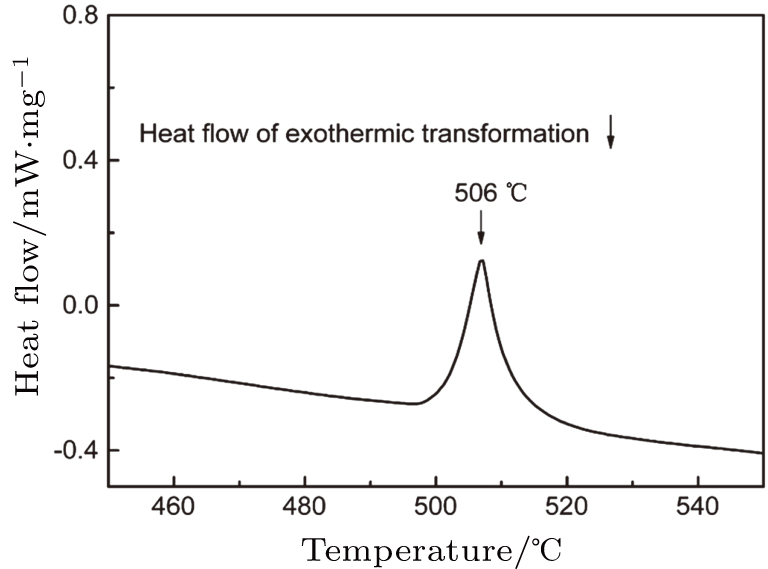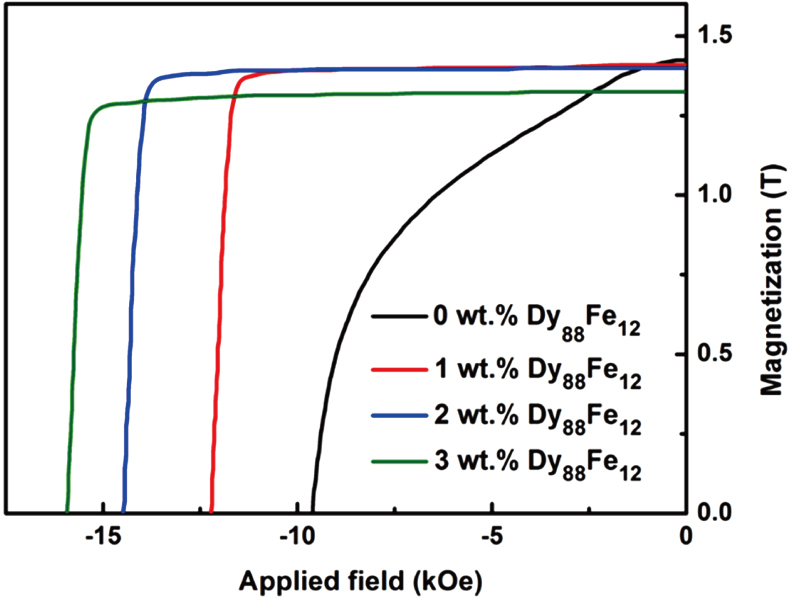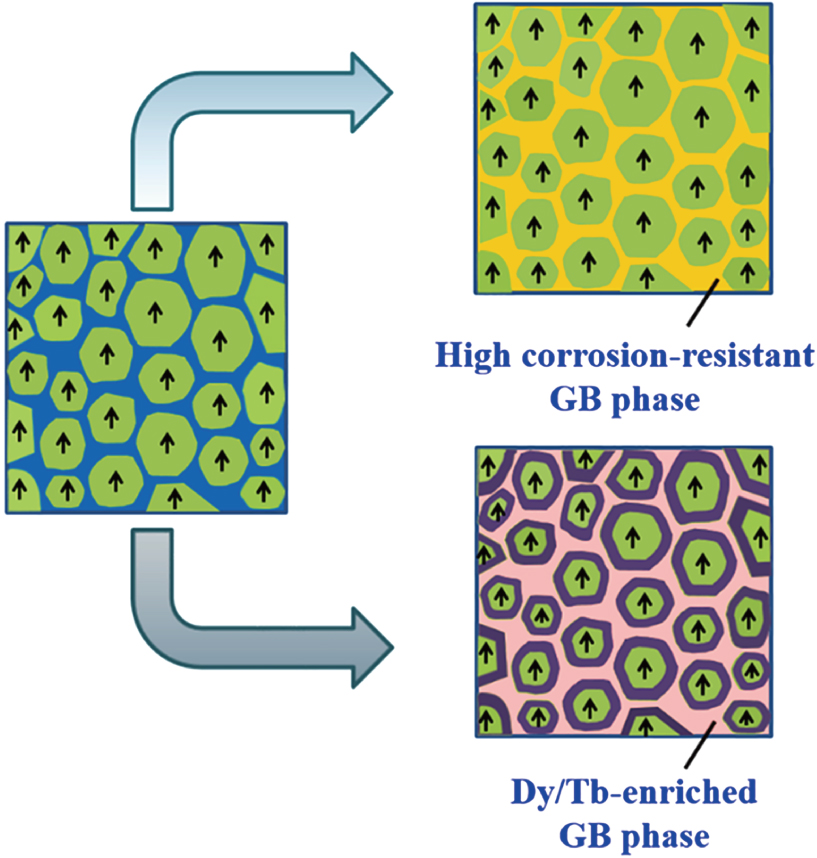† Corresponding author. E-mail:
Project supported by the National Natural Science Foundation of China (Grant Nos. 51801181, 51571176, 51590881, and 51622104), the National Key Research and Development Program of China (Grant No. 2016YFB0700902), the Key Research and Development Program of Zhejiang Province, China (Grant No. 2017C01031), and the Fundamental Research Funds for the Central Universities, China (Grant No. 2019QNA4011).
Since the 1980s, Nd–Fe–B with largest energy product (BH)max approaching the theoretical limit has become the landmark of permanent magnetic material. The application spectrum for Nd–Fe–B continues to expand over time both in the industrial and commercial sectors, which leads to growing research interests for solving the long-standing drawbacks of Nd–Fe–B, i.e., poor corrosion resistance, low coercivity, high Dy/Tb and low La/Ce/Y consumption. Concerning the above obstacles, we aim to present the novel grain boundary restructuring (GBR) approach, from GB design, processing, to structure evolution and property evaluation with a focus on the corrosion and coercivity mechanism of the restructured 2:14:1-typed magnets. Starting with an introduction to the fundamental of GBR, two representative examples, high-electrode-potential (Pr, Nd)32.5Fe62.0Cu5.5 and low-melting-point Dy71.5Fe28.5, are given with detailed descriptions of the advantages of GBR to enhance the intrinsic anti-corrosion stability and to strengthen the coercivity at low Dy consumption. Microstructure–property correlations are established to understand the critical importance of regulating the restructured GB phase to maximize the all-round performance of the 2:14:1-typed permanent magnets. Aiming at sustainable and balanced development of rare earth (RE) industry, the proceeding section proposes new prototypes of La–Ce and Y–Ce co-substitutions with dual benefits of stabilizing the 2:14:1 tetragonal phase and strengthening the intrinsic hard magnetism. The findings of additional REFe2 intergranular phase delight that the GBR approach also opens up a new horizon of research and application to develop high-performance La/Ce/Y-rich permanent magnets with deliberately tailored GB phase.
Nd–Fe–B, the icon of permanent magnetic material, has long served as an indispensable component in household and industrial sectors, given its large maximum energy product (
The Nd–Fe–B sintered magnets possess multi-phase morphologies, including the ferromagnetic Nd2Fe14B matrix phase (
Driven by the principle that the Nd-rich GB phase is critical to the corrosion resistance, coercivity, heavy RE utilization, as well as the high-abundant RE application in Nd–Fe–B magnets, we have devoted intense efforts in modifying the grain boundary.[35–52] The dual-alloy method invented in the 1990s inspired us the possibility of designing a novel GB alloy to replace the traditional Nd-rich phase. A novel approach, named as grain boundary restructuring (GBR), was proposed accordingly.[53] The concept of GBR can be elaborated as follows: focusing on the critical drawbacks of Nd–Fe–B magnets, i.e., low coercivity, chemical durability, and thermal stability, a new GB alloy is designed manually, fabricated separately, and evolved finally into the required morphology and structure through tuning the processing parameters. As it manifests itself, the restructured GB phase is totally distinct from the naturally Nd-rich phase and exerts a profound effect on the performance of the Nd–Fe–B magnets. The GBR approach affords a rich spectrum of possibilities for fabricating 2:14:1-typed permanent magnets with tuned performance, and it basically does not complicate the fabrication process. From this aspect, the GBR approach is quite promising for the massive applications.
After decades of development, we have established well-defined guidelines for designing the new GB alloy. The key points are proposed as follows.
1) According to the thermodynamic theory, the selected elements should hardly diffuse into the Nd2Fe14B matrix phase to guarantee the stable tetragonal structure and high intrinsic hard magnetism.
2) Based on the phase diagram, no soft magnetic phases should occur inside the composition profile of the new alloy to avoid the magnetic dilution effect.
3) From the perspective of magnetic properties, the new GB phase should exhibit a lower melting point than the Nd2Fe14B compound and good wettability with the matrix phase, which are essential for the magnet densification and the structural homogenization during sintering.
4) The corrosion theory indicates that the new GB phase should possess a higher corrosion potential to suppress the electrochemical corrosion and enhance the corrosion resistance.
A series of new GB alloys have been employed to increase the comprehensive performance of 2:14:1-typed magnets. Examples include (Pr, Nd)32.5Fe62.0Cu5.5,[54] Nd64Co36,[55] Nd6Co13Cu,[56] Dy69Ni31,[26] Dy32.5Fe62Cu5.5,[57] DyHx,[58] NdHx,[59] and Dy71.5Fe28.5.[60,61] In the following manuscript, recent developments on the (Pr, Nd)32.5Fe62.0Cu5.5 and Dy71.5Fe28.5 systems are selected as typical models to unveil the underlying mechanisms on improving the corrosion resistance and magnetic performance via the GBR approach.
According to the thermodynamic Miedemaʼs model,[62] the formation enthalpy for Nd/Fe/B mixing with Cu (−30 kJ/mol, +22 kJ/mol, and +2 kJ/mol, respectively) reveals that Cu hardly enters the 2:14:1 matrix phase. Consequently, the (Pr, Nd)32.5Fe62.0Cu5.5 alloy will not destroy the tetragonal structure, which benefits the high intrinsic magnetic properties. Moreover, one can see that Fe and Nd2Fe17 soft magnetic phases occur outside of the dark area in the phase diagram of Nd–Fe–Cu (Fig.
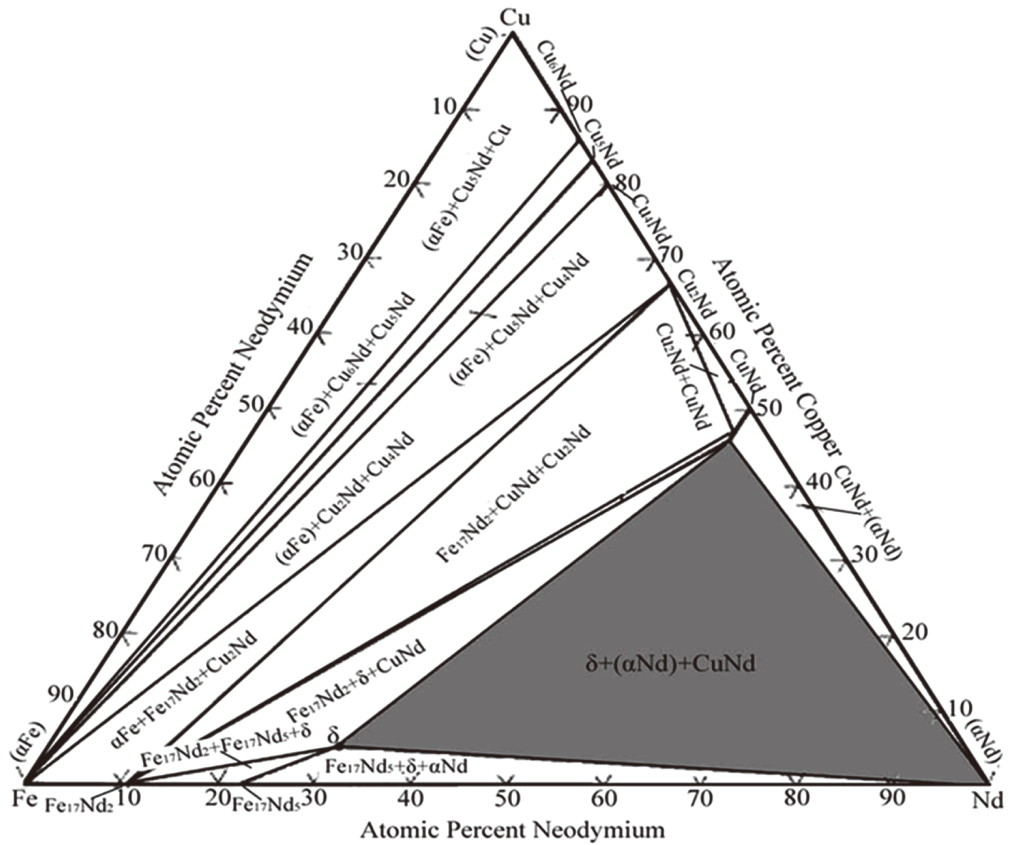 | Fig. 1. Nd–Fe–Cu isothermal section of phase diagram at 450 °C.[64] |
The magnets were fabricated using the GBR method. Master alloy powders with the nominal composition of (Pr, Nd)12.6Fe81.3B6.1 (at.%) were prepared by strip casting (SC), hydrogen decrepitating (HD), and jet milling (JM). The average particle size was approximately 

The corrosion weight loss curves of the samples exposed in a hot/humid atmosphere (120 °C, 2 bar, and 100% relative humid) are plotted in Fig.
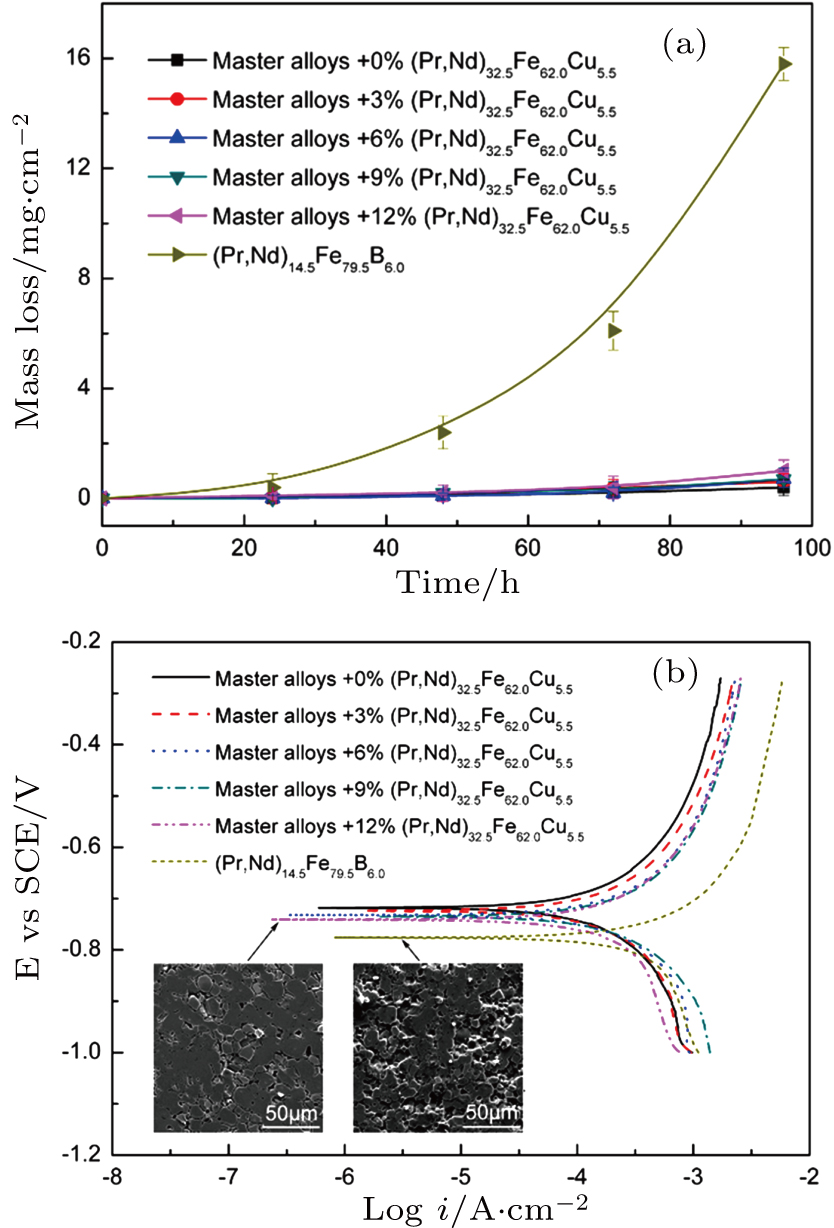 | Fig. 3. (a) Mass loss of (Pr, Nd)32.5Fe62.0Cu5.5 restructured magnets and (Pr, Nd)14.5Fe79.5B6.0 in hot and humid atmosphere. The error bar represents the standard deviation obtained from 5 samples. (b) Potentiokinetic polarization curves in 0.005 M H2SO4 aqueous solutions. The insets in (b) are SEM micrographs of the corroded surfaces of (Pr, Nd)14.5Fe79.5B6.0 and 12 wt.% (Pr, Nd)32.5Fe62.0Cu5.5 restructured magnets.[53] |
Figure 


Figure 



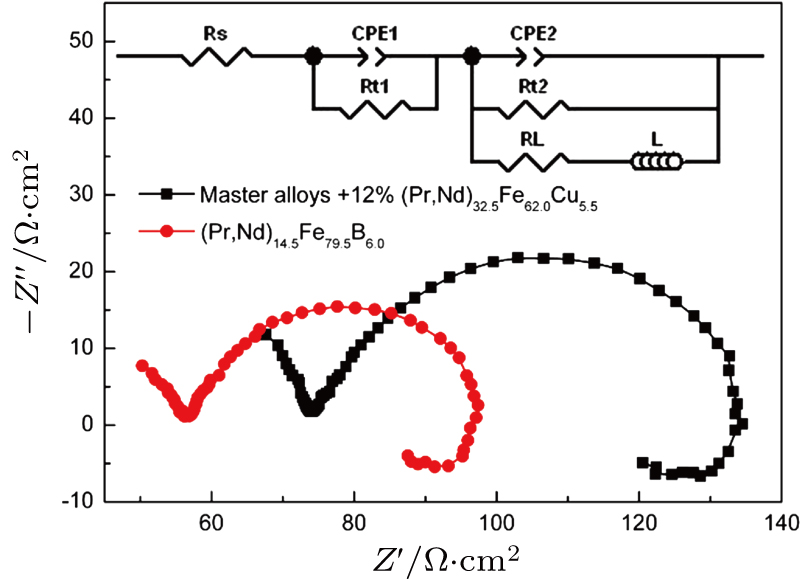 | Fig. 4. Nyquist plots of (Pr, Nd)14.5Fe79.5B6.0 and 12 wt.% (Pr, Nd)32.5Fe62.0Cu5.5 restructured magnet in 0.005 M H2SO4 solution. The corresponding equivalent circuit is illustrated as an inset. |
| Table 1.
Absorption resistance RL and charge transfer resistance Rt of the proposed equivalent circuit models in Fig. |
The backscattered electron image of the 12 wt.% (Pr, Nd)32.5Fe62.0Cu5.5 restructured magnets (Fig.
 | Fig. 5. (a) Back-scattered electron image of 12 wt.% (Pr, Nd)32.5Fe62.0Cu5.5 restructured magnet. EDS detection of intergranular phase at triple junction areas is shown as inset. (b) Corresponding STEM image and (c) EDS composition profile along the line shown in (b).[53] |
Figure 
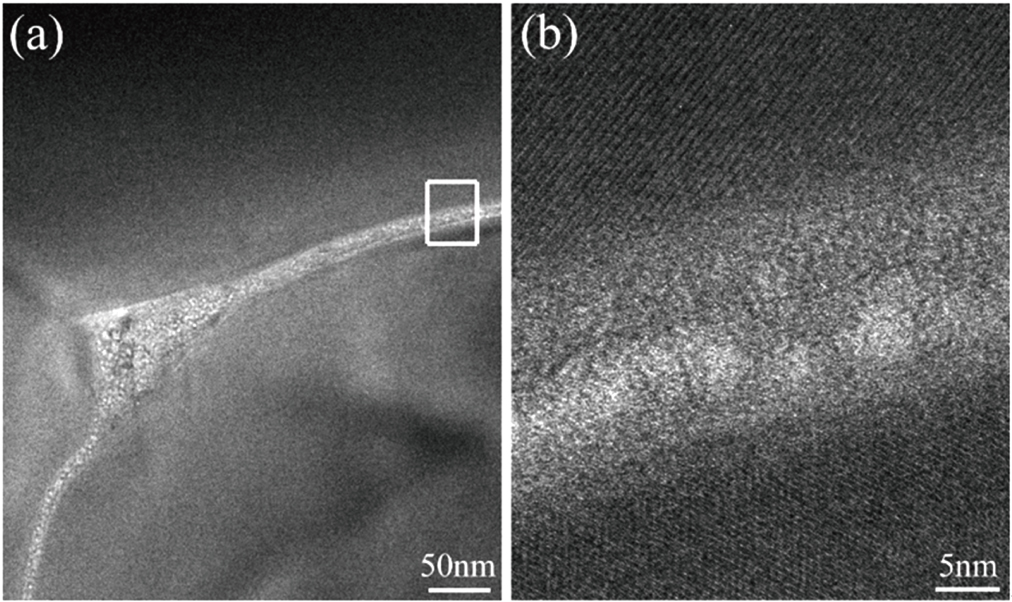 | Fig. 6. (a) Bright field TEM image of 12 wt.% (Pr, Nd)32.5Fe62.0Cu5.5 restructured magnet. (b) Corresponding HRTEM images of the rectangular region indicated in (a).[53] |
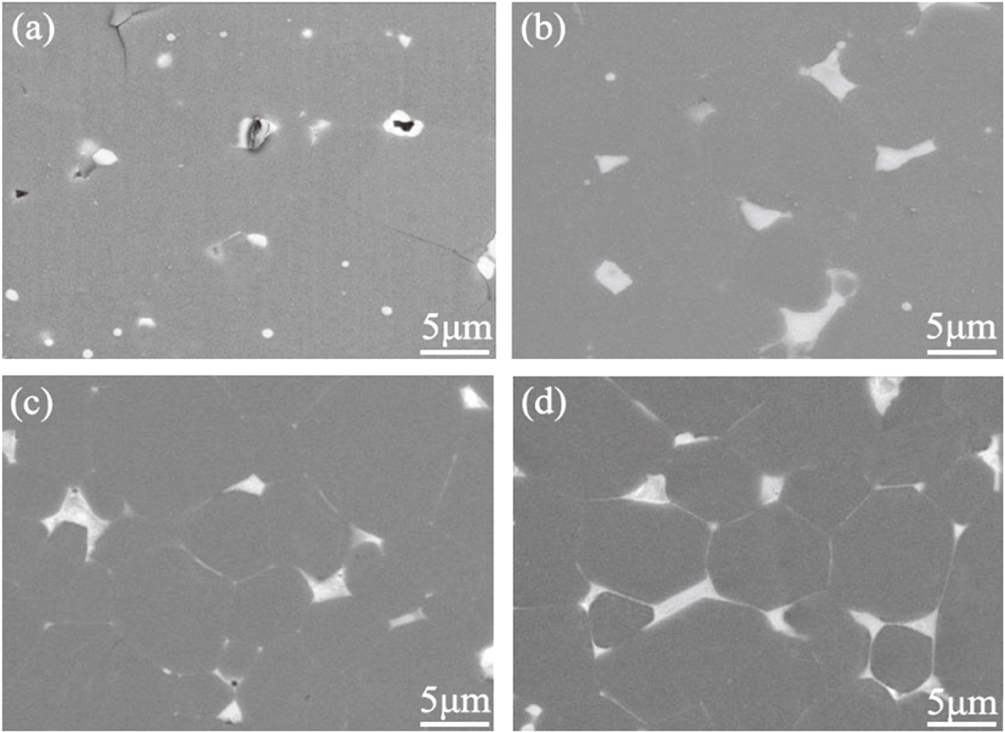 | Fig. 7. Back-scattered electron images of (a) the master alloy and magnets with (b) 3 wt.%, (c) 6 wt.%, (d) 9 wt.% (Pr, Nd)32.5Fe62.0Cu5.5.[54] |
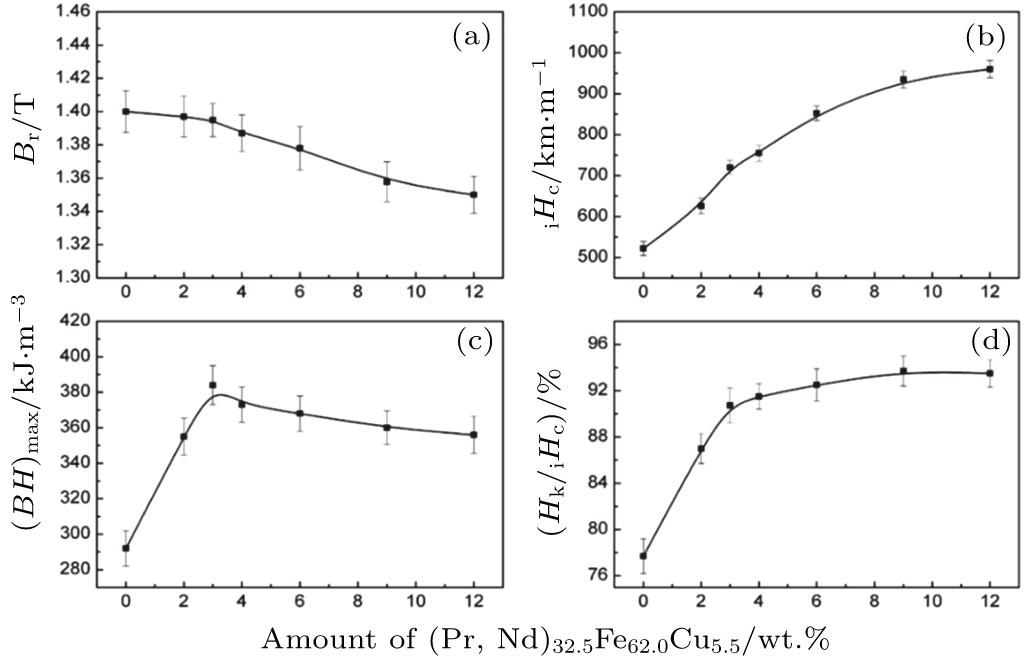 | Fig. 8. Variations of the remanence, intrinsic coercivity, maximum energy product, and rectangularity of demagnetization curve with the (Pr, Nd)32.5Fe62.0Cu5.5 content. The error bar represents the standard deviation obtained from 5 samples.[54] |
For the restructured magnet, the δ-phase (Pr, Nd)6Fe13Cu possesses an electrochemical potential of −0.806 V in 0.005 M H2SO4 solutions with respect to a saturated calomel electrode, which is substantially higher than that of the (Pr, Nd)-rich phase ((Pr, Nd)4Fe, −0.870 V). As a result, the δ phase has a far lower corrosion rate than the (Pr, Nd)-rich phase. Corrosion measurements of (Pr, Nd)6Fe13Cu alloys after 96 h exposure in hot/humid atmosphere show that their mass loss is 0.1 mg/cm2, which is quite similar to that of the (Pr, Nd)2Fe14B matrix phase, suggesting that they hardly react with H2O. The (Pr, Nd)-rich phase, however, is very sensitive to the water and exhibits a large mass loss of 256.8 mg/cm2 in hot/humid environments for only 24 h.[44] Thus, the replacement of (Pr, Nd)-rich phase by (Pr, Nd)6Fe13Cu can drastically reduce the sensitiveness of Nd–Fe–B magnets to H2O, being responsible for far better corrosion resistance of the restructured magnet against hot/humid atmosphere than the un-restructured one.
It is well established that the GBR approach can be applied to fabricate high corrosion-resistant (Pr, Nd)–Fe–B sintered magnets through replacing the intergranular (Pr, Nd)-rich phase by a (Pr, Nd)6Fe13Cu one. These restructured magnets exhibit the maximum energy products of 356.0–384.0 kJ/m3 (45–48 MGOe) and low mass losses of 0.3–1.0 mg/cm2 after exposing in hot/humid atmosphere for 96 h. The better corrosion resistance can be ascribed to the closer corrosion potential of the δ-type (Pr, Nd)6Fe13Cu GB phase to the (Pr, Nd)2Fe14B matrix phase. It reduces the potential difference between the cathodic matrix phase and the anodic GB phases, leading to the decreased driving force for the electrochemical corrosion. This fact, coupled with the amorphous structure and homogeneous distribution of intergranular GB phase, decreases the corrosion current density and thus improves the corrosion resistance. The enhanced corrosion resistance in both hot/humidity and acidic environments, and outstanding magnetic performance together indicate that the GBR approach is appealing to developing high corrosion-resistant Nd–Fe–B sintered magnets for mass production.
According to the magnetism of RE2Fe14B compounds and the phase diagram, the Dy71.5Fe28.5 aiding alloy is designed and introduced into the slightly off-stoichiometric Nd2Fe14B starting magnet through GBR approach. With a lower melting point of 874.5 °C (Fig.
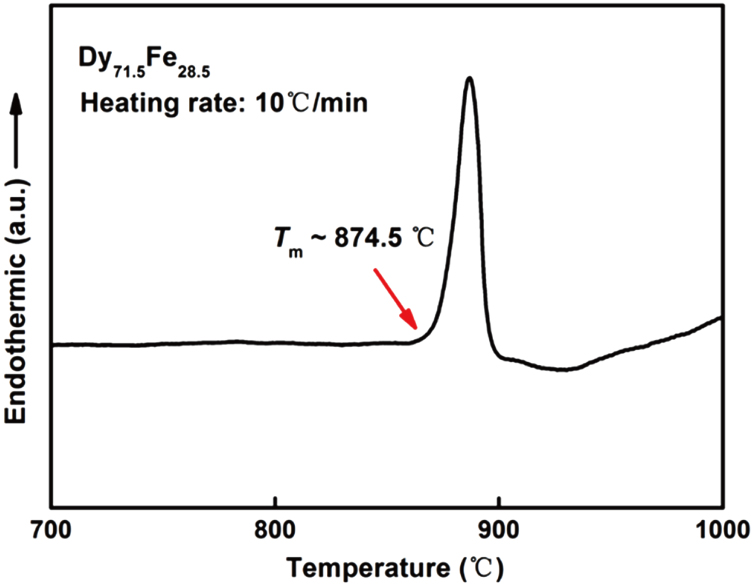 | Fig. 9. DSC curve of the Dy71.5Fe28.5 eutectic alloy.[61] |
Master alloy powders with the composition of (Pr, Nd)12.3FebalB6.1 were prepared by induction melting, SC, HD, and JM. The average particle size was approximately 

Figure
The Dy71.5Fe28.5 additives help densify the magnets and optimize the microstructure, as reflected by the back-scattered scanning electron microscope (SEM) micrographs (Fig.
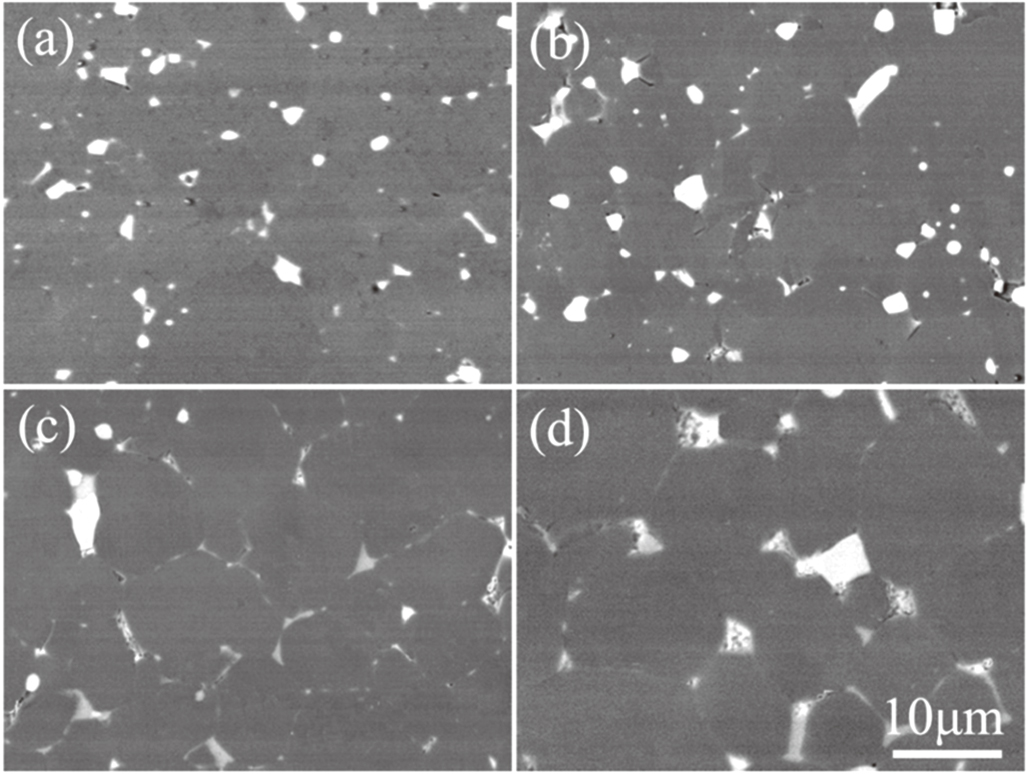 | Fig. 11. Back-scattered SEM micrographs of (Pr, Nd)12.3FebalB6.1 master alloy with (a) 0, (b) 1 wt.%, (c) 2 wt.%, and (d) 3 wt.% Dy71.5Fe28.5. |
It should be stressed that when the Dy71.5Fe28.5 addition is below 2 wt.%, i.e., the TRE content is less than 12.92 at.%, the coercivity is significantly enhanced without remanence deterioration. For Nd–Fe–B sintered magnets, both the continuous GBs and the hardening shell in the surface region of 2:14:1 phase grains are necessary for obtaining high coercivity. Elemental distributions for the 2 wt.% Dy71.5Fe28.5 restructured magnets are shown in Fig. 
 | Fig. 12. Nd and Dy mapping in GBs and 2:14:1 phase grains of 2 wt.% Dy71.5Fe28.5-restructured magnet.[60] |
A comparison between our low TRE-content magnets and the reported 48BH magnets fabricated by different approaches is illustrated in Fig.
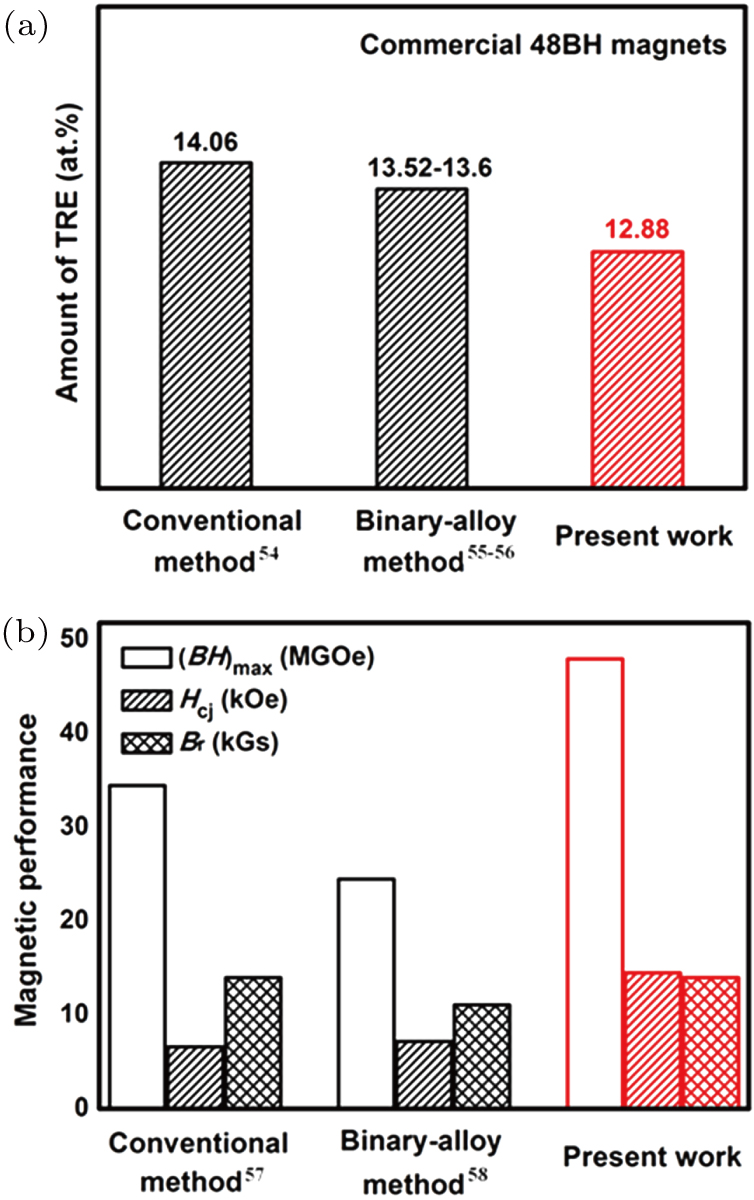 | Fig. 13. A comparison of (a) TRE content of commercial 48BH magnets, and (b) magnetic performance of the magnets with similar TRE content. |
The GBR approach has been proved to be effective in fabricating high-performance magnets with low TRE content of 12.6–12.92 at.%. With the low-melting-point Dy71.5Fe28.5 additives, there are two main microstructural modifications in (Pr, Nd)12.3FebalB6.1 master alloys. Firstly, the high magnet density contributes to enhanced (BH)max and Br. Secondly, efficient Dy/Tb utilization by constructing a Dy/Tb-rich hardening shell surrounding the Nd2Fe14B core and uniform GB layer isolating the magnetically hard 2:14:1 matrix grains can strengthen the Hcj substantially. Via this GBR approach, lower TRE content of only 12.92 at.% is employed for 48BH magnet. Meanwhile, the magnets exhibit better magnetic performance than reported ones with the same TRE content level.
Based on the above analysis, the GBR magnets generally exhibit the following features (Fig.
1) The GBR approach focuses on the manually designed GB phase, being distinct from the traditional Nd-rich phase.
2) The new GB phase with higher electrode potential can decrease the driving force for the electrochemical reactions between the matrix and intergranular phases, succeeding in fabricating high corrosion-resistant Nd–Fe–B magnets.
3) Through adding low-melting-point Dy-containing alloys, a magnetic hardening shell with higher HA and continuous GBs are formed, contributing to the enhanced coercivity.
4) Coercivity increment by per unit Dy addition can be effectively enhanced through the GBR approach, without sacrificing the remanence and energy product.
5) By blending these new GB alloys with low melting points into near-stoichiometric Nd2Fe14B main alloys, the total rare earth consumption can be reduced significantly, being promising for mass production.
Rare-earths, the natural gems with unique chemical and physical properties, are indispensable components in many emerging and critical technologies.[19–23] In China, the main RE supplier, ∼40 wt.% of such strategic sources are consumed by the 2:14:1-typed Nd–Fe–B magnets.[22] However, continually growing demand for Nd–Fe–B magnets and insecure supply for those closely-relied Nd/Pr/Dy/Tb due to geologic scarcity, extraction difficulties, and political volatility have caused severe concerns about REs availability, which may exert spill-over effects on global economy and security in the case of defense or military sectors.[20,78] Meanwhile, high-abundant and inexpensive La/Ce/Y[5–9] (by-products of Nd/Pr/Dy/Tb during mineral extraction) are rarely used due to the inferior magnetic properties of (La/Ce/Y)2Fe14B to Nd2Fe14B.[4–18]
Recently, significant progress has been achieved that the binary main phase approach, i.e., sintering the mixture of 2:14:1-type Ce-free and Ce-containing powders, can suppress the magnetic dilution effect and induce preferable magnetic performance of (Nd, Ce)–Fe–B magnets. As a result, the Ce substitution level in Nd–Fe–B magnets has been significantly increased. Magnetic properties of (BH)max = 43.3 MGOe, Br = 13.6 kG, and Hcj = 9.26 kOe have been obtained with 30 wt.% Ce substitution for Nd.[7] The application of La and Y, however, is still a big challenge for balanced utilization of RE resources.[19–23]
Stable 2:14:1-type tetragonal structure is the prerequisite for affording high intrinsic magnetic properties. However, under the circumstance of sole La substitution, unstable La2Fe14B phase tends to transform into α-Fe and La–B upon annealing at elevated temperatures in both as-cast and melt-spun La–Fe–B systems due to the large atomic radius of La.[18] Consequently, high La substitution for Nd in the (Nd, La)2Fe14B compounds has long been limited.[80] In our work, a new prototype of La–Ce co-substitution was proposed.[23] La of larger atomic radius expands the 2:14:1 phase lattice, induces the Ce valence shift towards +3 configuration, and strengthens the magnetization. Consequently, La and Ce can be utilized simultaneously, which not only guarantees the stability of La-containing 2:14:1 tetragonal phase, but also enhances the intrinsic magnetism of the Ce-rich 2:14:1 compounds.
| Table 2.
Refined lattice parameters a, c, and V, and R factors for the [(Pr, Nd)1−x(La, Ce)x]2.14Fe14B powders (x = 0–0.5).[23] . |
Alloys with the nominal composition of [(Pr, Nd)1−x(La, Ce)x]2.14Fe14B (x = 0, 0.1, 0.2, 0.3, 0.4, and 0.5) were prepared by induction melting and subsequent strip-casting at a copper wheel velocity of 1–4 m/s, which is commonly used for mass production of Nd–Fe–B sintered magnets. The raw materials include high-purity (above 99.5%) La–Ce alloy (35 wt.% La, 65 wt.% Ce), Pr–Nd alloy (20 wt.% Pr, 80 wt.% Nd), Fe–B (81.5 wt.% Fe, 18.5 wt.% B) alloy, and Fe metal.
Figure 





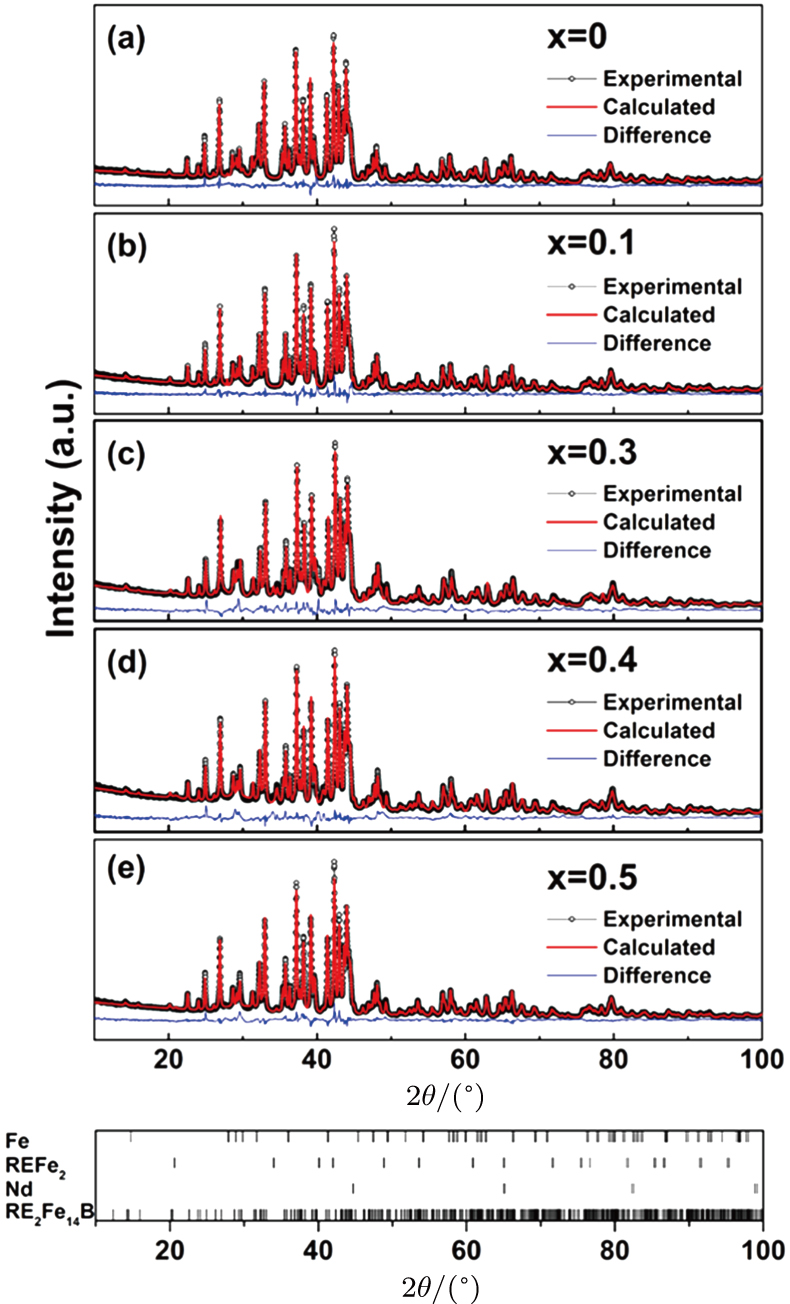 | Fig. 15. Rietveld refinement of step-scanned XRD patterns of [(Pr, Nd)1−x(La, Ce)x]2.14Fe14B powders for (a) x = 0, (b) x = 0.1, (c) x = 0.3, (d) x = 0.4, and (e) x = 0.5 at room temperature. Experimental pattern, calculated pattern, and their differences are shown in black, red, and blue colors, respectively. Bottom ticks mark the characteristic Bragg positions of RE2Fe14B, Nd, REFe2, and Fe phases, and serve as a guide to the eye.[23] |
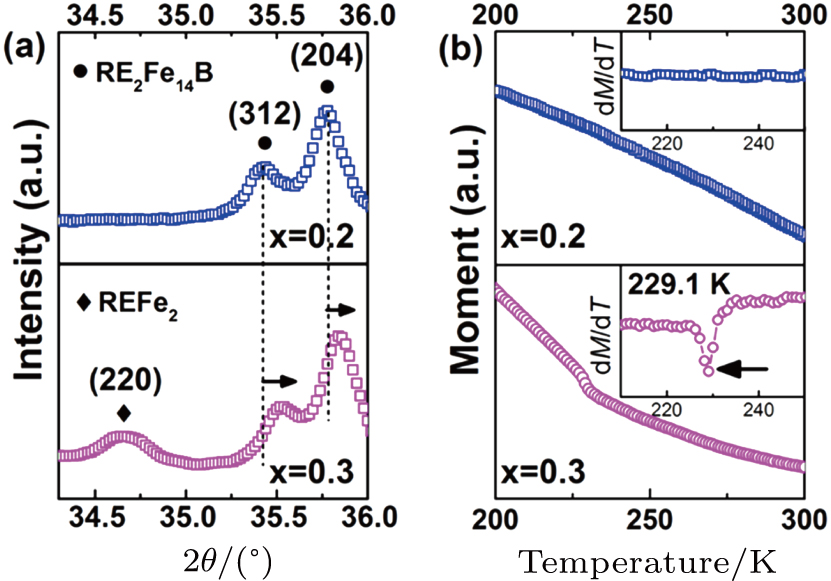 | Fig. 16. (a) Enlarged XRD patterns of 2θ between 34.3° and 36° for samples of x = 0.2 and x = 0.3. (b) M–T curves for the samples (x = 0.2 and x = 0.3) in the temperature range of 200–300 K. Their corresponding 
|
Figure 

 |
 |
 |
 |
 |
 |


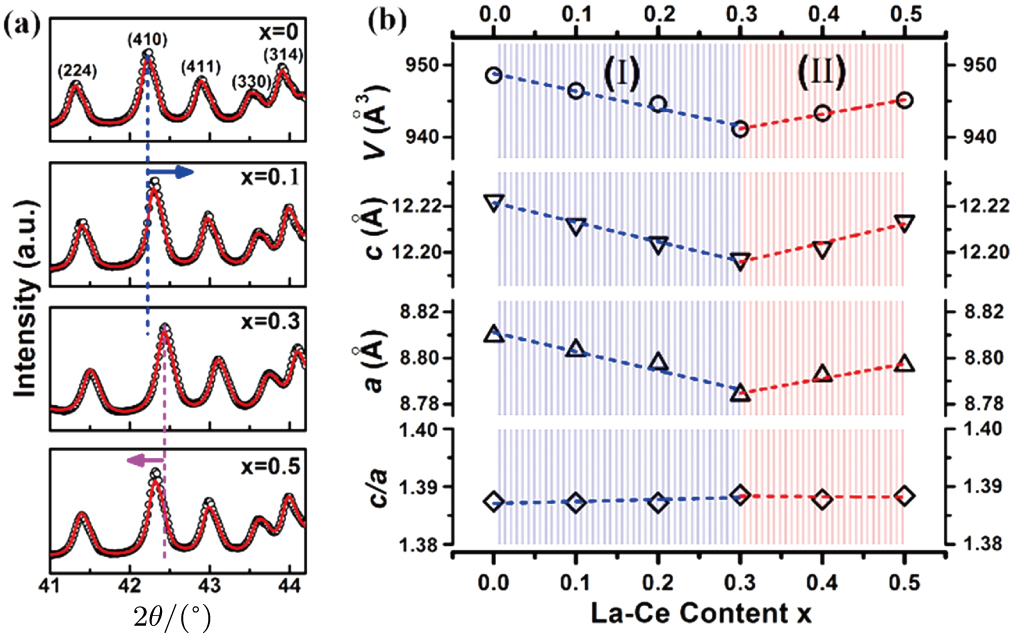 | Fig. 17. (a) Enlarged Rietveld refined XRD patterns of 2θ between 41°–44.2° for [(Pr, Nd)1−x(La, Ce)x]2.14Fe14B powders. (b) Dependences of lattice parameters a, c, c/a ratio and unit cell volume V of the 2:14:1 tetragonal phase on the La–Ce content x.[23] |
Sole La substitution generally leads to 2:14:1 phase instability. However, in the present work of La–Ce co-doping, the c/a ratio keeps basically unchanged (Fig.
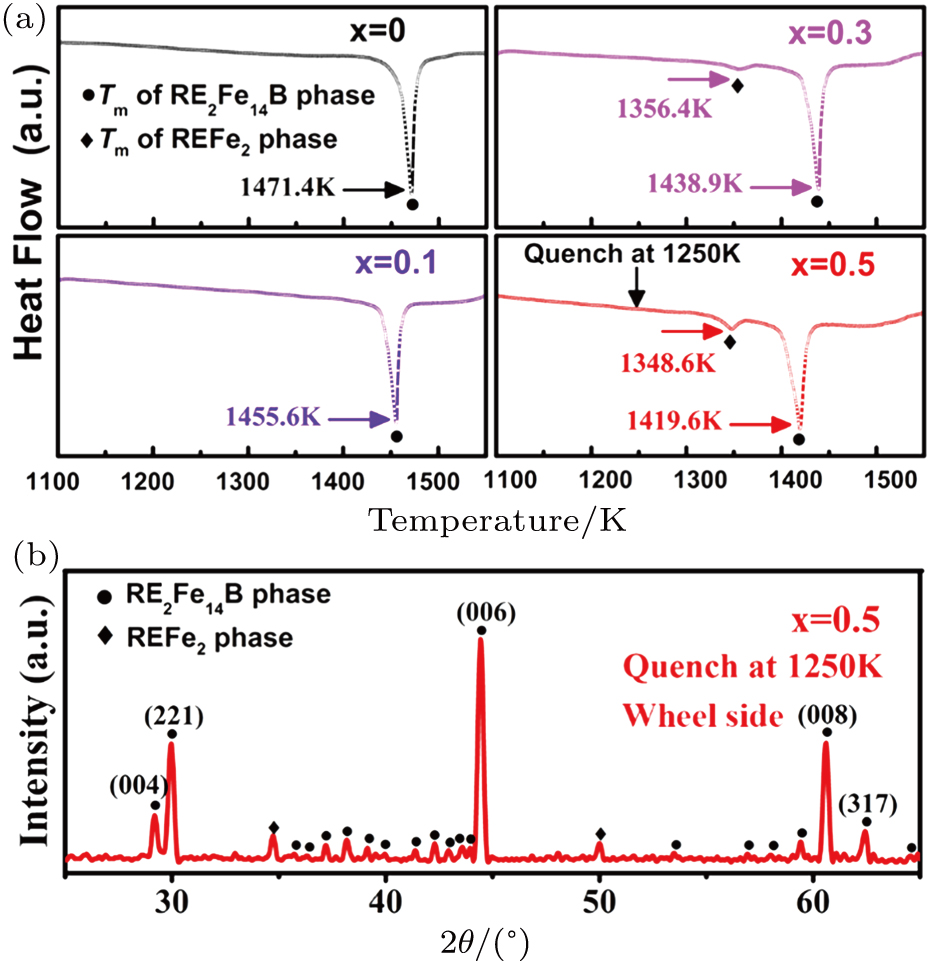 | Fig. 18. (a) DSC curves for specimens with x = 0, 0.1, 0.3, and 0.5 upon heating to 1550 K at 20 K/min. (b) XRD pattern of the as-quenched [(Pr, Nd)0.5(La, Ce)0.5]2.14Fe14B (x = 0.5) strip after annealing at 1250 K for 1 h.[23] |
Since the chemical state of Ce is sensitive to neighboring environment,[9] there is a high possibility that the Ce valence changes with varied x. As Ce3+ ion possesses a substantially larger radius (∼1.14 Å) than that of Ce4+ (∼0.97 Å), the appearance of Ce valence towards one 4f-carrying +3 is expected to produce the anomalous lattice expansion. XPS characterizations verify the Ce valence change with increasing La–Ce content, as depicted in Fig. 





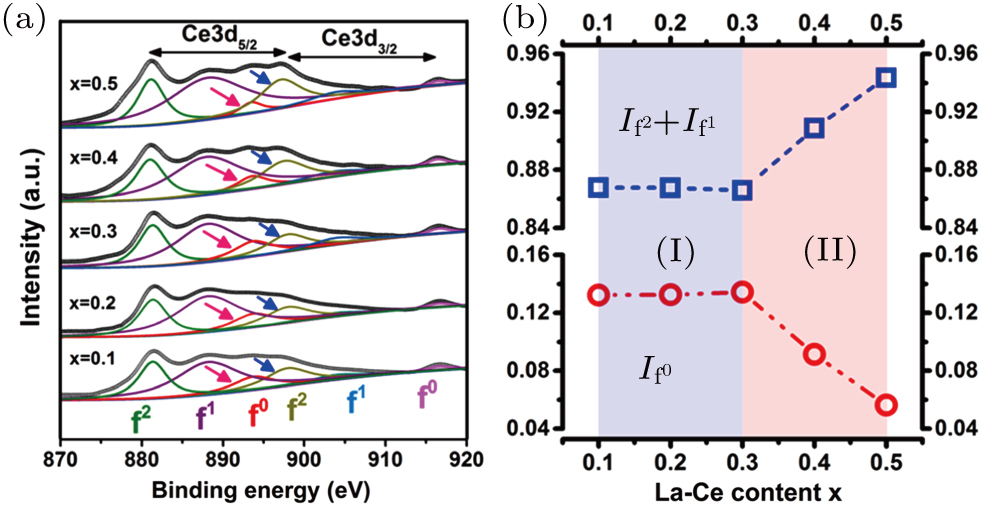 | Fig. 19. (a) XPS spectra of the Ce 3d level in [(Pr, Nd)1−x(La, Ce)x]2.14Fe14B strips with x = 0.1–0.5. (b) The derived intensities of 

|
 | Fig. 20. XPS spectra of (a) B 1s level, (b) Fe 2p level, (c) La 3d level, and (d) Nd 3d level in [(Pr, Nd)1−x(La, Ce)x]2.14Fe14B strips with x = 0.1–0.5.[23] |
Figure 
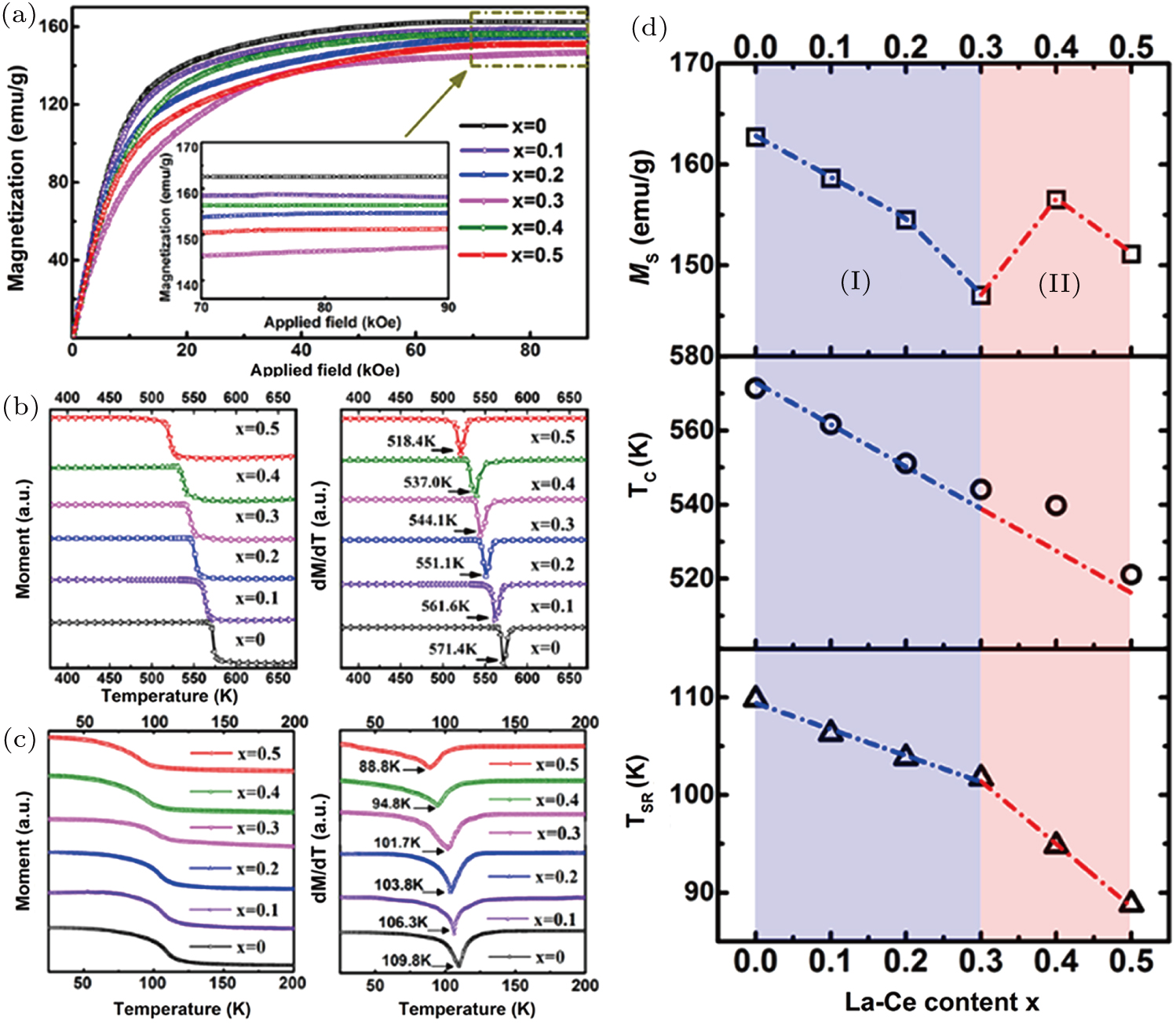 | Fig. 21. (a) Initial magnetization curves measured at 295 K. The inset is an enlarged view of the high-field regime. The M–T and 
|
Previous research has shown that sole La substitution for Nd is beneficial to enlarge the unit cell size of the 2:14:1 phase and Ce incorporation alone decreases the lattice. In this study, La and Ce co-doping into the (Pr, Nd)2.14Fe14B compounds during induction melting, however, results in non-linear variation of the lattice parameters with increasing La–Ce content x. At low La–Ce doping levels (x below 0.3), the reduced lattice constants are dominated by Ce addition. Afterwards, when the La–Ce content is above 0.3, the influence of La on expanding the unit cell increases (Fig.
The finding that Ce valence can be manipulated by La–Ce co-doping is of significant importance. La with larger atomic radius plays an indispensable role in inducing a favorable Ce valence shift and higher intrinsic magnetic properties, thus suppressing the magnetic dilution in La/Ce-containing RE2Fe14B system. It provides a substantial possibility for developing high-performance RE–Fe–B magnets at significantly reduced material cost. As of February 2016, the cost of La–Ce alloy is approximately one-twelfth of Pr–Nd alloy (up-to-date RE cost is available at the website), thus the total material cost can be lowered by about 57% with 50 at.% La–Ce replacement for Pr-Nd, e.g., $22 per kg for (Pr, Nd)2Fe14B versus $9.5 per kg for [(Pr, Nd)0.5(La, Ce)0.5]2.14Fe14B. In our on-going work, bulk (Pr, Nd, La, Ce)–Fe–B sintered magnets are prepared with La–Ce content as high as 50%. As shown in Fig.
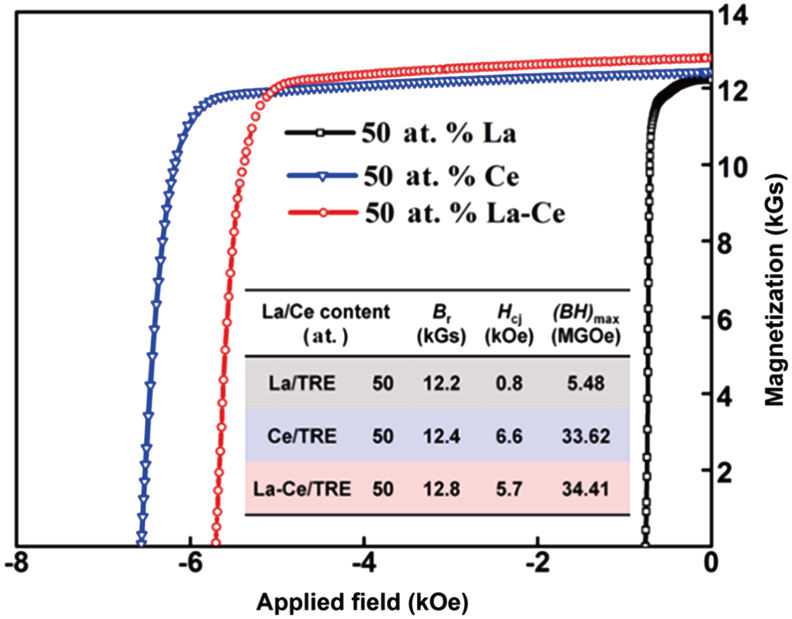 | Fig. 22. Demagnetization curves of sintered permanent magnets with 50 at.% La–Ce substitution, compared to those with La or Ce incorporation alone. The inset shows the detailed magnetic properties including Br, Hcj, and (BH)max.[23] |
Magnetic powders with nominal compositions of (Pr, Nd)29.8Gd1.7FebalM1.1B1.0 (I: La/Ce-free terminal) and (Pr, Nd)20.3(La, Ce)9.5Gd1.7FebalM1.1B1.0 (II: La/Ce-rich terminal, with 30 wt.% La–Ce concentration of TRE) (M = Cu, Al, Nb, Zr, in wt.%) were prepared by induction melting, strip casting, hydrogen decrepitation, and jet milling. The raw material Pr–Nd alloy denotes a 20 wt.% Pr–80 wt.% Nd composition, and the La–Ce alloy is composed of 35 wt.% La and 65 wt.% Ce. By tuning the mass ratios of the two typed powders, multiple main phase (MMP) magnets of 9 wt.%, 12 wt.%, 15 wt.%, 18 wt.% La–Ce (La–Ce content of TRE) were prepared via conventional powder metallurgy process. After pressed under 5.5 MPa in a perpendicular magnetic field of 1.5 T and isostatic compressing under 200 MPa, the green compacts were sintered at 1000–1075 °C and subsequently annealed at 870–900 °C and 460–620 °C. Meanwhile, the starting magnet (by only using La/Ce-free terminal) and single main phase (SMP) magnets (by direct alloying 3 wt.%, 6 wt.%, 9 wt.% La–Ce into component I) were prepared under the same condition.
Despite that the back-scattered SEM image (Fig.
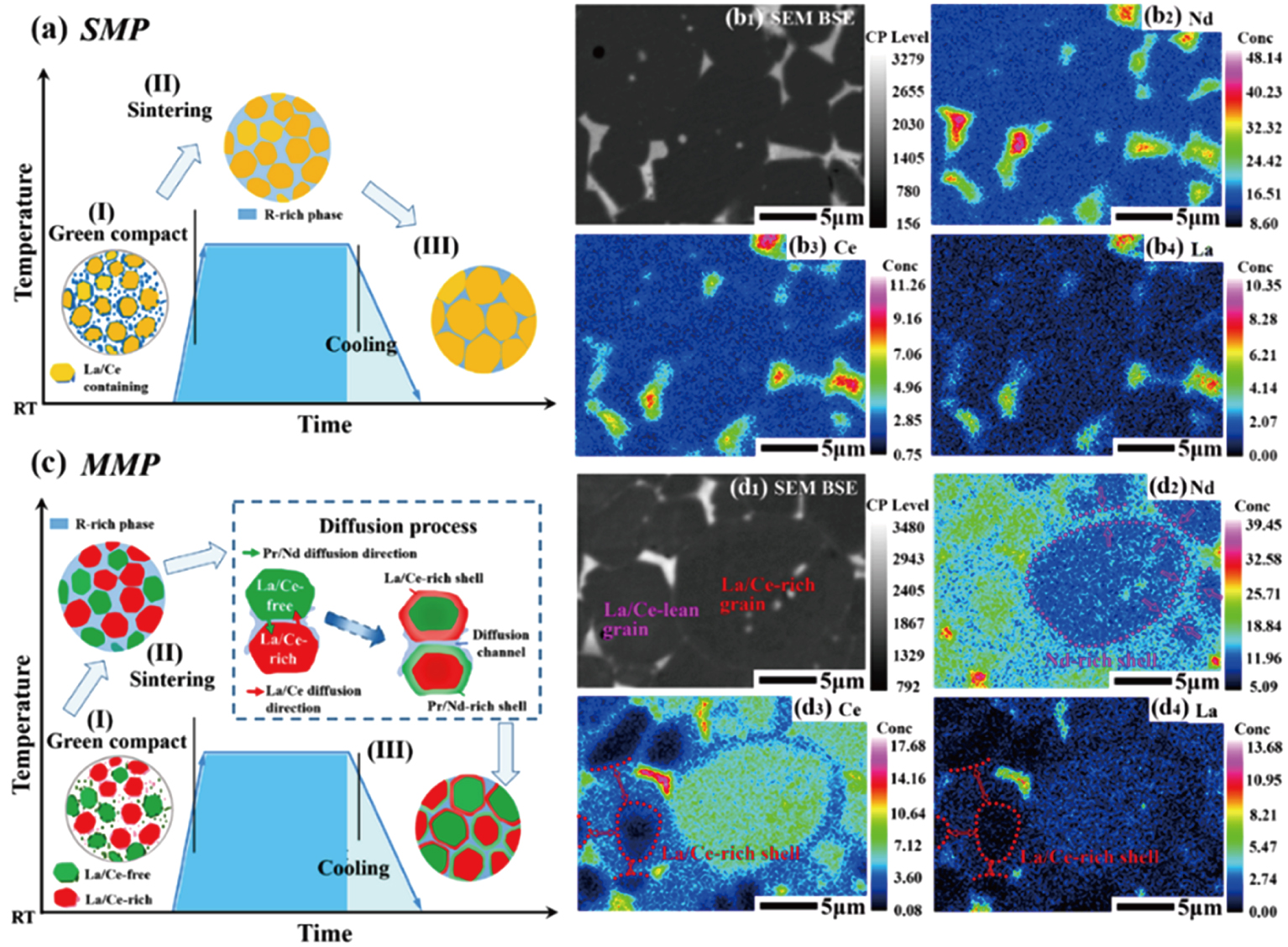 | Fig. 23. Chemical heterogeneity of MMP magnets compared to the chemically homogeneous SMP ones. Schematics in (a) and (c) show the evolution of different microstructures for SMP and MMP magnets, respectively. Back-scattered SEM micrographs (bright and grey contrasts refer to RE-rich and matrix phases, respectively) and corresponding elemental mappings of Nd, Ce, and La for (a) MMP magnet with 18 wt.% La–Ce/TRE and (b) SMP magnet with 9 wt.% La–Ce/TRE. (e) Room temperature demagnetization curves for SMP and MMP magnets. (f) Dependence of magnetic properties on La–Ce concentration for SMP and MMP magnets.[22] |
TEM characterizations of MMP magnets show that the inhomogeneous La/Ce distribution within or across the grains does not break the crystal symmetry of the main phase (Figs. 

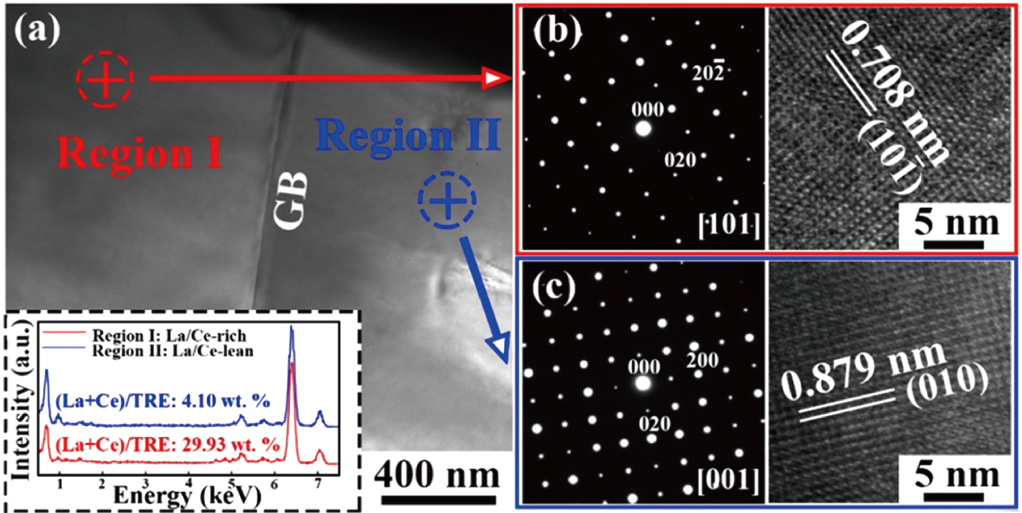 | Fig. 24. Local crystal features of the MMP magnet with 18 wt.% La–Ce. (a) Bright field image. The inset is EDS spectra at regions I and II, showing the detailed (La + Ce)/TRE ratio (wt.%). SAED pattern and HRTEM image of (b) region I and (c) region II in (a).[22] |
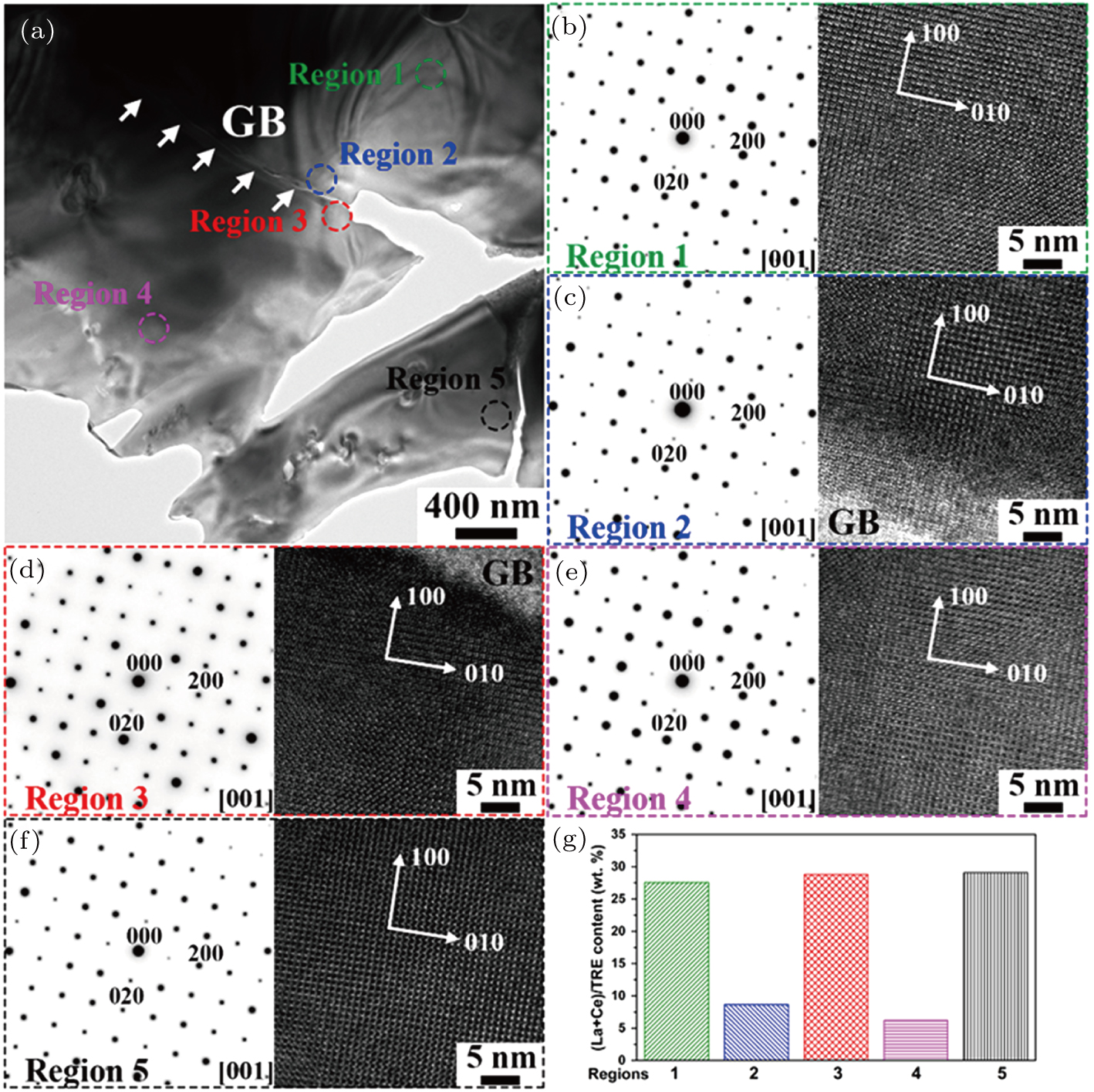 | Fig. 25. Local crystal features of the MMP magnet. (a) Bright field image showing five local regions numbered 1–5. Their corresponding SAED patterns and HRTEM images are shown in (b)–(f), respectively. Their (La + Ce)/TRE contents (wt.%) are plotted in (g).[22] |
A following critical question then arises: how does the local fluctuation of intrinsic magnetic properties influence the macroscopic magnetization reversal? To answer this question, the local magnetic domain structure of the MMP magnet is characterized by Lorentz TEM (Fig.
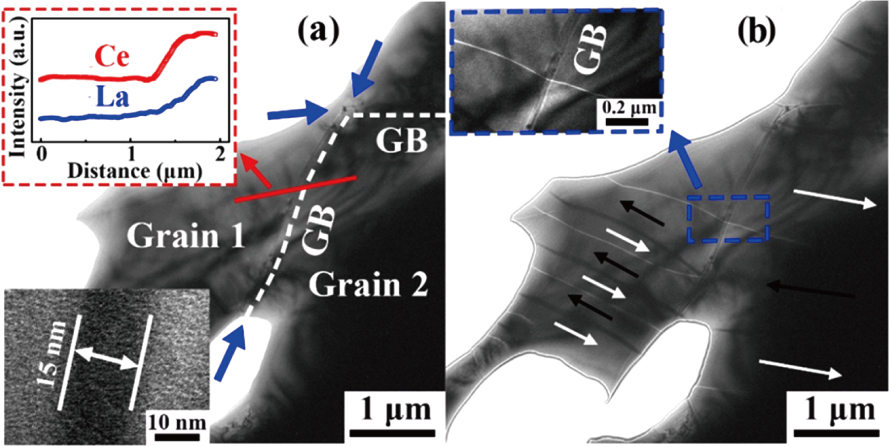 | Fig. 26. Local domain features of the MMP magnet with 18 wt.% La–Ce. (a) In-focus and (b) over-focus Lorentz TEM images of the thermally demagnetized sample (c-axis in-plane view). In the in-focus image, neighboring grains 1 (low La/Ce) and 2 (high La/Ce) are separated by the GB layers (indicated by white dotted curves and blue arrows). The upper inset shows the EDS line scan (red solid line), and the bottom one is an enlarged view of the GB regions (∼15 nm). The over-focus image reveals bright and dark contrasts of the domain walls (an alternating 180° wall pattern, as depicted by arrows), which are produced by opposite magnetizations between adjacent domains. The inset in (b) enlarges a continuous domain wall across the thick GB.[22] |
 | Fig. 27. The c-axis out-of-plane Kerr view of SMP and MMP magnets. Magneto-optical Kerr images of thermally demagnetized (a) SMP magnet with 9 wt.% La–Ce and (c) MMP magnet with 18 wt.% La–Ce. The average domain width in the MMP magnet is almost twice the size of the SMP one. The pink arrows in (c) depict the domain clusters that joint together with 

|
 | Fig. 28. The in situ magnetization reversal process of the MMP magnet with 18 wt.% La–Ce, recorded by magneto-optical Kerr images. The external magnetic field is applied to the specimen along the c-axis (in-plane). Upon decreasing the external field and afterwards increasing the reversal field, the magnetization reversal can be divided into four steps: (a) nucleation of reversed domains near the GBs at 120 mT, which then grow within the grain and thus become more visible at 100 mT and 70 mT. (b) Gradual propagation of reversed domains with the increasing opposite field (
|
Room-temperature demagnetization curves in Fig. 
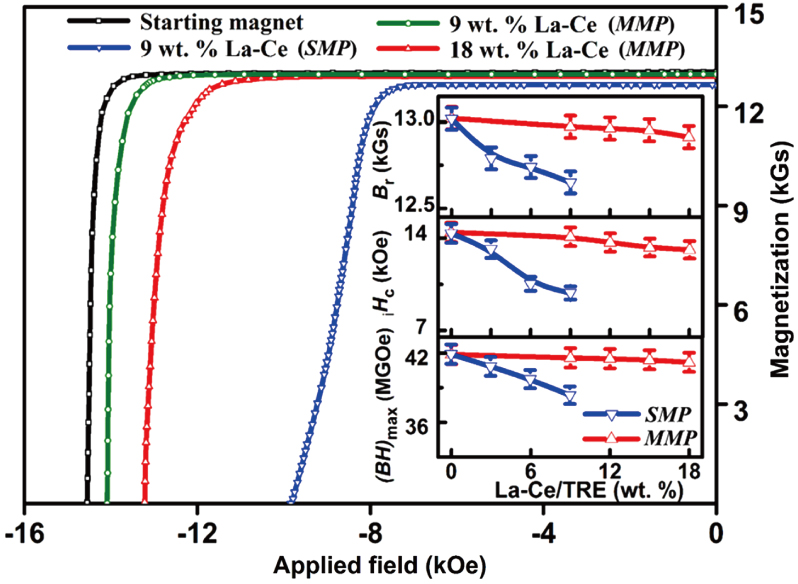 | Fig. 29. Magnetic performance of MMP magnets compared to the SMP ones. The inset shows the dependence of magnetic properties on La–Ce content.[22] |
 | Fig. 30. Thermal stability of SMP and MMP magnets. (a) Temperature coefficients of remanence α and coercivity β (from 20 °C to 100 °C). (b) Dependence of irreversible flux loss on the temperature (from 20 °C to 150 °C) for SMP and MMP magnets.[22] |
| Table 3.
Magnet compositions and performance. La–Ce/TRE, mass ratio of La/Ce-free component I/(I+ II), average compositions, and magnetic performance. Comp. I denotes the La/Ce-free terminal, and Comp. II denotes the La/Ce-rich one. . |
Further magnetic measurements (Fig. 



 | Fig. 31. Short-range and long-range magnetic interactions. (a) M–T and (b) 



|
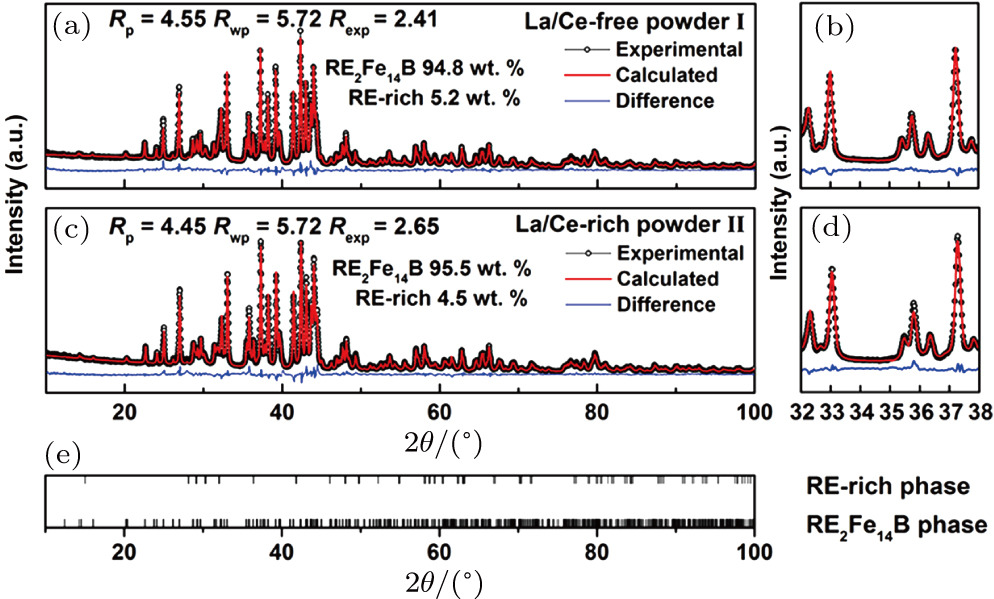 | Fig. 32. XRD analysis of the initial La/Ce-free and La/Ce-rich components. Rietveld refinement of step-scanned XRD patterns for (a) La/Ce-free powder I and (c) La/Ce-rich powder II (La–Ce/TRE = 30 wt.%) at room temperature. Experimental pattern, calculated pattern, and their differences are shown in black, red, and blue colors, respectively. The difference pattern in each curve indicates a good matching between the calculated and experimental values. The enlarged XRD patterns of 2θ between 32° and 38° are shown in (b) and (d), respectively. Bottom ticks in (e) mark the characteristic Bragg positions of the RE2Fe14B/RE-rich phase, and serve as a guide to the eye.[22] |
 | Fig. 33. XRD analysis of the SMP and MMP magnets. (a) Rietveld refinement of step-scanned XRD patterns for La/Ce-containing SMP and MMP magnets (in powders) at room temperature. Experimental pattern, calculated pattern, and their differences are shown in black, red, and blue colors, respectively. The difference pattern in each curve indicates a good matching between the calculated and experimental values. The enlarged XRD patterns of 2θ between 32.8° and 35° are shown in (b). Bottom ticks in (c) mark the characteristic Bragg positions of the RE2Fe14B/RE-rich phase, and serve as a guide to the eye.[22] |
Reversible and irreversible magnetization 





The novel prototype of La/Ce-rich RE–Fe–B magnets with chemical heterogeneity either over local regions within an individual grain or across grains is completely distinct from the SMP magnet with REs homogenously distributed in the main phase, and those with singular core–shell structure.[25,87,88] Besides the peculiar chemical heterogeneity of the MMP magnet, its high magnetic performance further underscores the dependence of local intrinsic magnetic property/lattice parameter on the composition and its close ties to the extrinsic magnetic properties.[89] It is remarkable that the short-range exchange coupling and long-range magnetostatic interaction can induce higher remanence and coercivity simultaneously than those of the SMP magnets with the same average composition.
In dynamic environments, such as high-speed motors and electric power steering motors, the magnets should endure substantial mechanical stress, thereby requiring a high fracture resistance.[90] Not only the magnetic performance but also the mechanical properties are highly desired for such end-product applications. For Nd–Fe–B sintered magnets, the metallic Nd-rich phase has a relatively higher plasticity and ductility when compared to the intermetallic Nd2Fe14B phase, leading to a predominating intergranular fracture behavior.[91] The incorporation of La/Ce into Nd–Fe–B magnets by the MMP approach, however, may exert complex influences on the traditional intergranular fracture mechanism.[92,93] Since the La/Ce substitution for Nd in the 2:14:1 phase may change the intrinsic mechanical properties as well as the physicochemical properties (such as the melting point), microstructures as well as elemental distributions of such MMP magnets may have a distinct difference from those of the conventional Nd–Fe–B sintered magnets. Consequently, understanding the relationship between the La/Ce content, microstructure, and mechanical properties is of great significance in mass production of La/Ce-containing RE–Fe–B magnets and deserves a comprehensive investigation.
In our previous work,[93] magnetic powders with nominal compositions of (Pr, Nd)29.8Gd1.7FebalM1.1B1.0 (I: La/Ce-free) and (Pr, Nd)14.1(La, Ce)15.7Gd1.7FebalM1.1B1.0 (II: La/Ce-containing) (M = Cu, Al, Nb, Zr, in wt.%) were blended at different mass ratios (see Table
| Table 4.
La–Ce content of total rare earth (La–Ce/TRE), mass ratio of I/(I+II), and stoichiometric composition of the MMP magnets.[93] . |
Compared to the La/Ce-free starting magnet with Br = 13.0 kGs, Hcj = 14.4 kOe, and (BH)max = 41.9 MGOe, the MMP magnet with 18 wt.% La–Ce possesses fairly good magnetic performance with Br = 12.7 kGs, Hcj = 12.2 kOe, and (BH)max = 39.7 MGOe, which are comparable to the 40 MGOe commercial grade magnets. Dependences of the mechanical properties on the La–Ce content are shown in Fig. 







 | Fig. 34. The variation of mechanical properties as a function of La–Ce content. (a) Compressive strength 

|
As is known that the mechanical properties of Nd–Fe–B magnets are highly dependent on the microstructure, such as the grains size and RE-rich phase distribution, microstructure characterizations are then carried out to unveil the related mechanisms, focusing on the La–Ce concentrations above 18 wt.%, which is the turning point in the variations of bending and compressive strengths. The back-scattered SEM images in Fig.
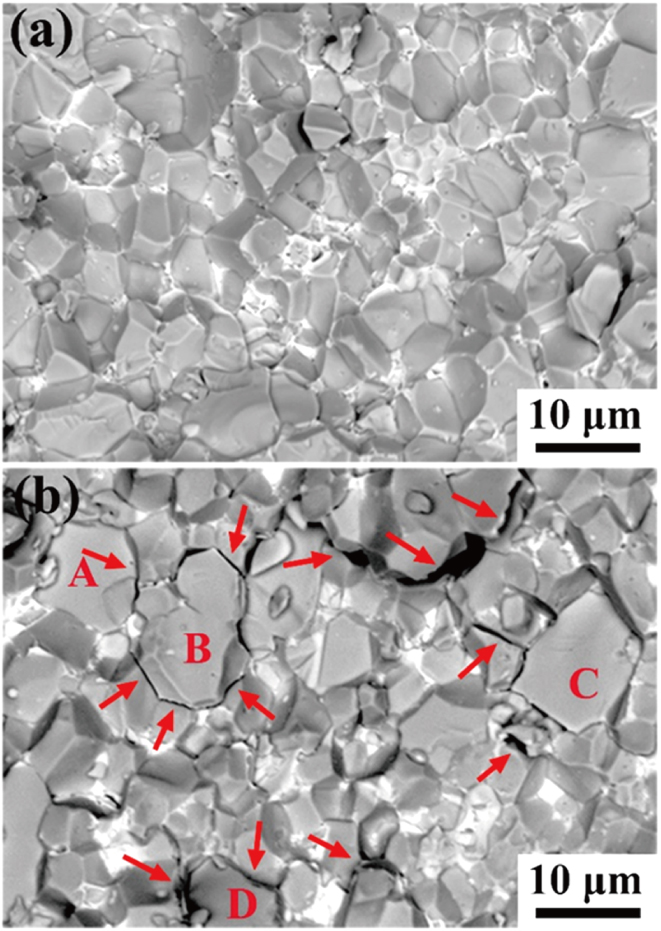 | Fig. 35. Back-scattered SEM images of fractured surface for the MMP magnets with (a) 18 wt.% La–Ce and (b) 36 wt.% La–Ce after the three-point bending test.[93] |
At 18 wt.% La–Ce concentration (Fig. 


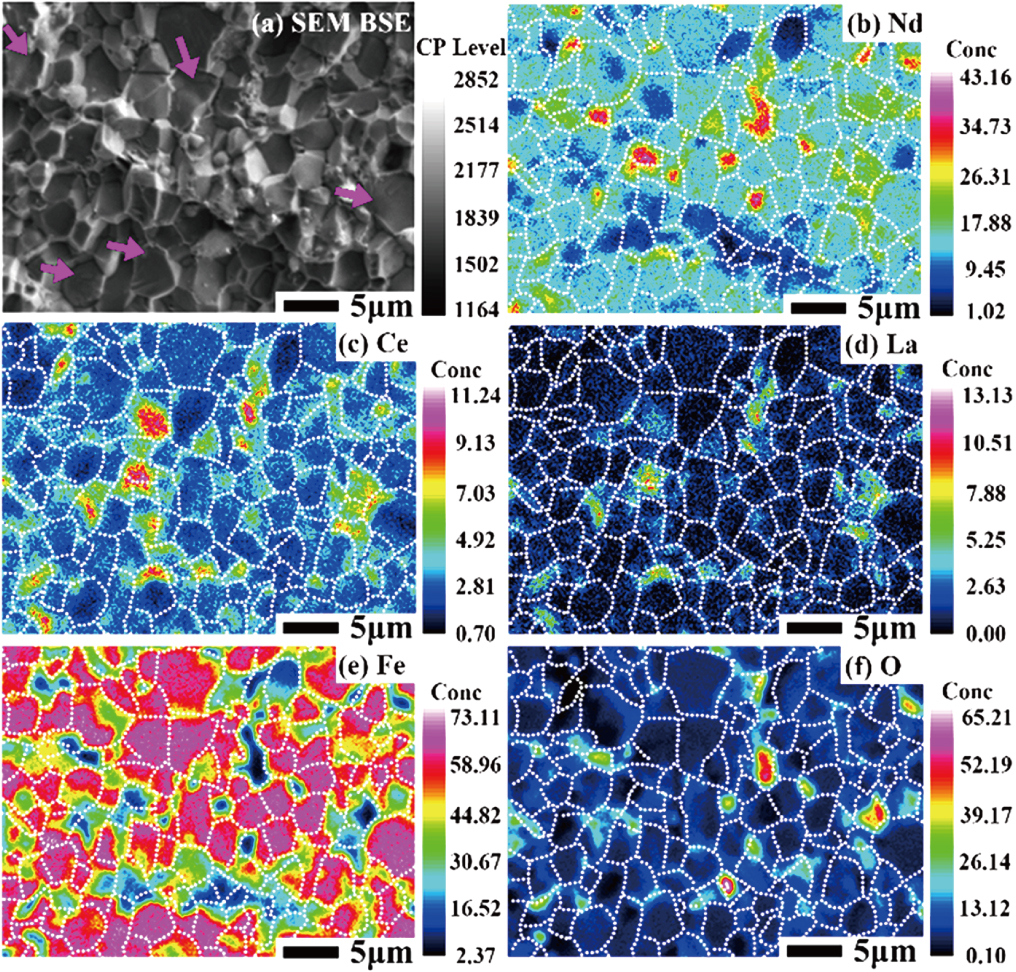 | Fig. 36. (a) Typical fractograph and EPMA mappings of (b) Nd, (c) Ce, (d) La, (e) Fe, and (f) O for the MMP magnet with 9 wt.% La–Ce.[93] |
Apart from the RE2Fe14B grains, the RE-rich phase at GBs also plays a key role in determining the mechanical properties. It is noteworthy that at a high La–Ce concentration (Fig.
Additionally, transgranular cleavage can also be partially found in the fractograph of specimens. Given that the green compacts of MMP magnets consist of La/Ce-free and La/Ce-rich components, inhomogeneous La/Ce distribution among 2:14:1 matrix phase grains still exists even after the sintering and annealing. La/Ce-rich and La/Ce-lean RE2Fe14B grains coexist in the final magnets. To uncover the relationship between the phase components and transgranular fracture, EPMA is employed as shown in Fig.
In our work, a promising solution to the tightening global REs criticality is unveiled by preparing high-performance RE2Fe14B magnets with high La–Ce concentration. The hallmark lies in the chemical heterogeneity within/across the magnetically hard 2:14:1 phase grains, making it one crucial topic from both the fundamental and application points of view. Theoretically, it offers a rich field for studying the interplay between chemical heterogeneity, interactions at different scales, and extrinsic magnetic properties in hard magnetic materials. Technologically, since most procedures remain the same as those in the conventional approach, the construction of chemical heterogeneity is promising for manufacturing La–Ce containing RE2Fe14B PMs in mass production, which may greatly promote the sustainability, balance, and diversity of global RE industry.
In comparison with La, whose 2:14:1 tetragonal structure is unstable, Ce can fully substitute for Nd in the Nd2Fe14B phase and is more appealing to develop low-cost RE–Fe–B magnets. However, it is noted that Ce2Fe14B has the lowest Curie temperature (TC = 424 K) among all the RE2Fe14B compounds.[4] Consequently, the sintered magnets with Ce substitution exhibit poor thermal stability. How to improve the thermal stability of Nd–Ce–Fe–B sintered magnets becomes a bottleneck concern for the high-temperature applications, such as wind turbines and hybrid vehicles. One of the common approaches to improve the thermal stability of Nd–Fe–B magnets is to enhance the Curie temperature. Previous investigations on Nd–Ce–Fe–B magnets show that TC can be increased by partial Co substitution for Fe at the sacrifice of remanence and coercivity.[5] Alternatively, the thermal stability can also be improved in high-coercivity magnets via incorporating heavy rare earth (HRE) elements Dy/Tb. However, the remanence reduction and the material cost increment become inevitable. In addition to TC and the increased coercivity, in fact, the temperature dependence of the magnetocrystalline anisotropy field and the magnetization is also essential because it determines how fast the intrinsic ferromagnetism decreases upon heating. Note that Y2Fe14B has an equivalent HA to Ce2Fe14B, but a much larger JS (1.41 T) at room temperature and higher TC (565 K).[4] Most importantly, Y2Fe14B has a positive temperature coefficient of anisotropy field over a wide temperature range,[72] which suggests that Y is a potential candidate for enhancing the thermal stability of the Nd–Ce–Fe–B magnets. In our work, Y was incorporated to improve the thermal stability of the (Nd, Ce)–Fe–B sintered magnets.[94,95]
Magnetic powders with nominal compositions of (Pr, Nd)30.5FebalM1.3B1.0 (Pr–Nd alloy consists of 20 wt.% Pr and 80 wt.% Nd, M = Cu, Al, Ga, Zr, Co, in wt.%), (Pr, Nd)15.25Ce15.25FebalM1.3B1.0, and (Pr, Nd)15.25(Y35Ce65)15.25FebalM1.3B1.0 were prepared by induction melting, SC, HD, and JM. By tuning the mass ratios of the Y-free and Y-containing powders, magnets with 6 wt.%, 9 wt.%, and 12 wt.% Y–Ce content of TRE (the corresponding Y content is 2.1 wt.%, 3.15 wt.%, and 4.2 wt.%, respectively) were prepared via the powder metallurgy route. The starting magnet (Y–Ce free) and the magnet with 9 wt.% Ce content were also prepared under the same condition for comparison. After pressing under 5.5 MPa in a perpendicular magnetic field of 15 kOe and isostatic compressing under 200 MPa, the green compacts were sintered at 1273–1348 K and subsequently annealed at 1143–1173 K and 733–893 K, respectively.
Figure
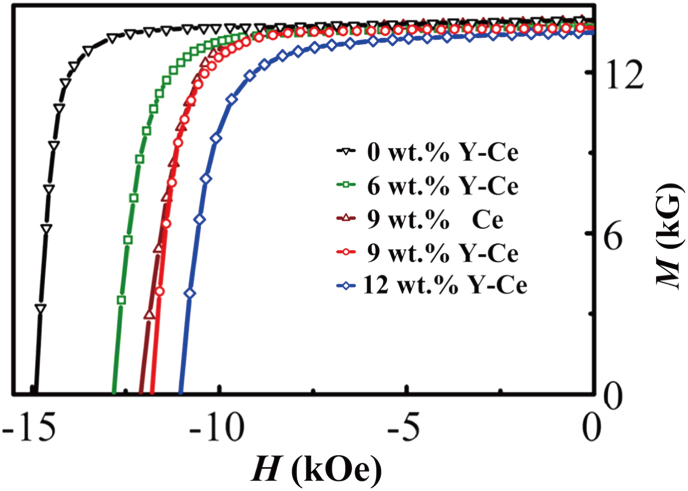 | Fig. 37. Room-temperature demagnetization curves for the starting magnet, the magnets with 6 wt.%, 9 wt.%, and 12 wt.% Y–Ce and 9 wt.% Ce substitution.[95] |
Further measurements at elevated temperatures show that the magnets with Y–Ce co-substitution have much better thermal stability than the one with single Ce substitution. Temperature coefficients of remanence (α) and coercivity (β) were evaluated by the in situ heating demagnetization curves over the temperature range from 293 K to 393 K. Typical curves for the magnet with 9 wt.% Y–Ce and the one with 9 wt.% Ce are illustrated in Figs.
 | Fig. 38. Demagnetization curves at selected temperatures upon in situ heating for (a) the magnet with 9 wt.% Y–Ce substitution and (b) the magnet with 9 wt.% Ce substitution for Nd.[95] |
A comparison of the temperature coefficients α and β among all the studied magnets is illustrated in Fig. 






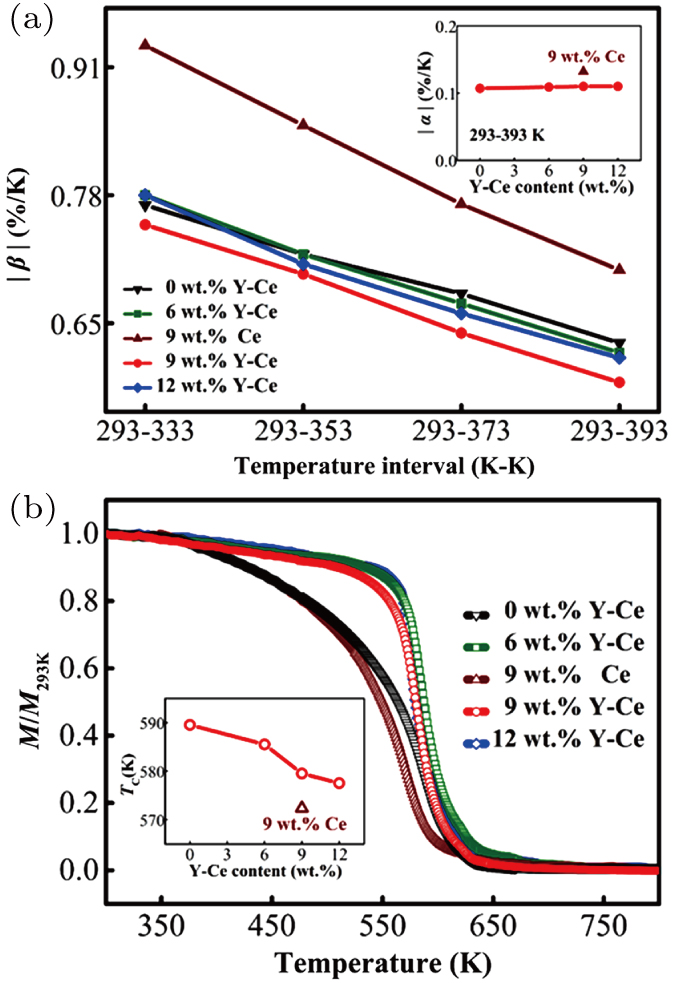 | Fig. 39. (a) The absolute values of temperature coefficients of coercivity for the starting magnet, the magnets with 6 wt.%, 9 wt.%, and 12 wt.% Y–Ce and 9 wt.% Ce substitution in different temperature intervals. The inset shows the absolute values of temperature coefficients of remanence within the temperature interval from 293 K to 393 K for the corresponding magnets. (b) Normalized magnetization measured as a function of temperature in 10 kOe. 
|
Figure 


Microstructure observation in Fig.
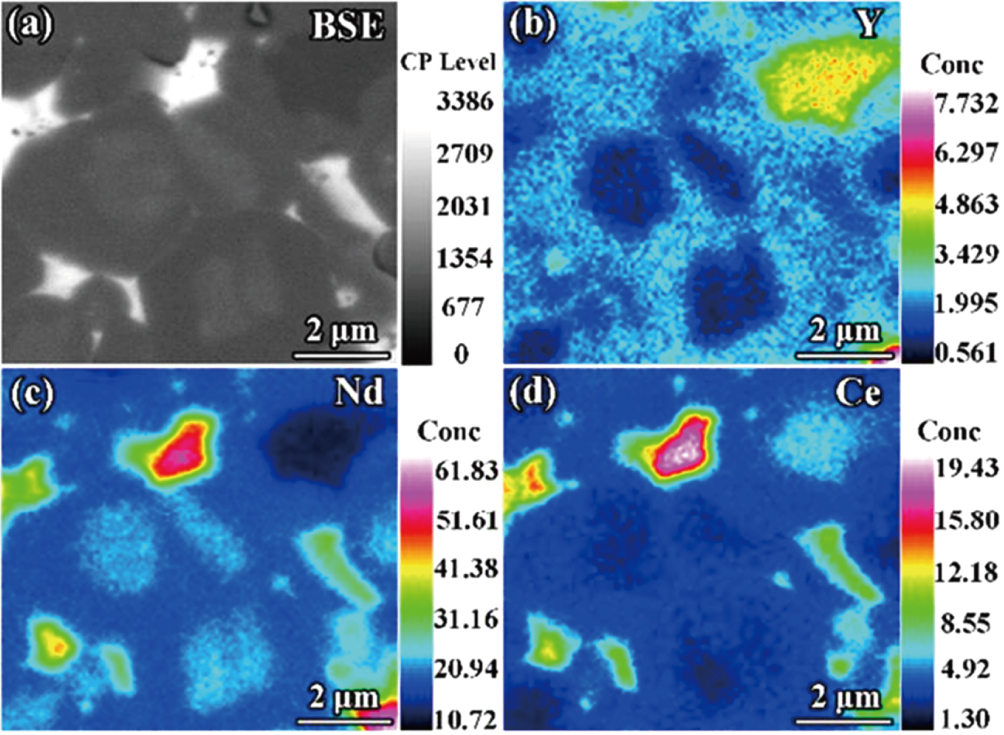 | Fig. 40. (a) BSE-SEM micrograph and corresponding elemental mappings of (b) Y, (c) Nd, and (d) Ce for the magnet with 9 wt.% Y–Ce substitution.[95] |
The above results indicate that Y plays a positive role on improving the thermal stability of the RE–Fe–B permanent magnets, which may bring important consequences. In comparison with Nd, Pr, Dy, and Tb, both Ce and Y are less-risky REs. By partial Y substitution for Ce, the temperature coefficient of the coercivity can be reduced by 16.2%. To further evaluate the thermal stability of Y–Ce co-substituted magnets, a commercial magnet with comparable magnetic performance of (BH)max = 44.0 MGOe, Br = 13.4 kG, and Hcj = 11.0 kOe was introduced. The temperature coefficients 



High Ce substitution may result in the formation of additional phases, whose contents and distributions strongly affect the macroscopic magnetic properties, especially the coercivity. Early work by Herbst et al.[97] has shown that the melt-spun Ce17Fe78B6 alloy contains up to 12 wt.% CeFe2 in addition to the Ce2Fe14B matrix phase. Other studies have also shown that REFe2 phase forms when the Ce content in Nd–Ce–Fe–B exceeds the critical values.[16,98–100] Consequently, it has been considered that the REFe2 phase inevitably forms in the Nd–Ce–Fe–B component with high Ce content. Its existence has been thought to be harmful to the magnetic performance due to its lower intrinsic magnetic parameters than the 2:14:1 phase. CeFe2 is paramagnetic at room temperature and magnetically soft even below its TC.[101] Considering that CeFe2 has a lower melting point (925 °C) than the sintering temperature for 2:14:1 magnets, it is inspiring to understand how the REFe2 phase affects the liquid-phase sintering process and the microstructure of the magnets. In this work, a Ce-free component and a Ce-containing component (Ce in the total RE is 50 wt.%) that contains REFe2 phase are designed to fabricate the MMP magnets. The distribution of REFe2 phase and its influences on both microstructure and magnetic properties of the magnets have been investigated.
A Ce-containing component [(Pr, Nd)0.5Ce0.5]30.5FebalM1.0B1.0, M = Al, Cu, Ga, Zr, in wt.%) (hereafter named as Ce-50) and a Ce-free component (Pr, Nd)30.5FebalM1.0B1.0 (hereafter named as Ce-0) have been designed. Each component was subjected to induction melting, SC, HD, and JM. The mean particle size of the final powders is 
Figure
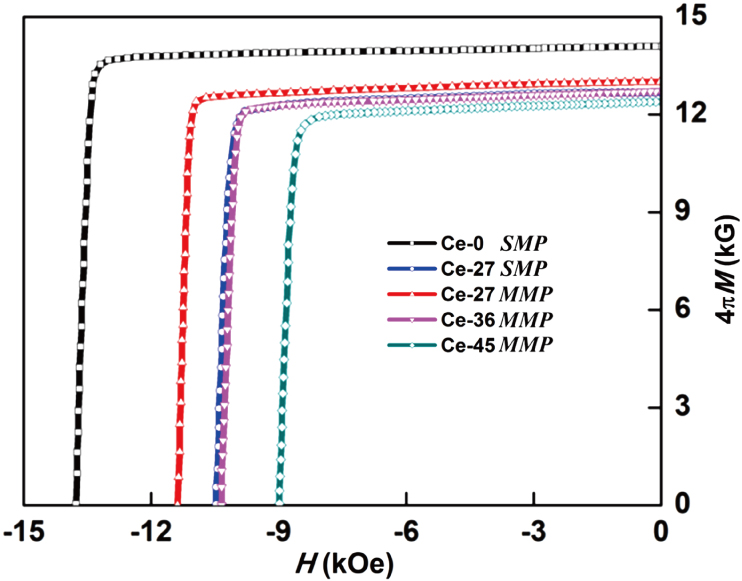 | Fig. 41. Room temperature demagnetization curves for the Ce-0 and Ce-27 magnets prepared by SMP approach, the Ce-27, Ce-36, and Ce-45 magnets prepared by the binary main phase MMP approach.[6] |
As indicated by arrows with different colors in Fig. 
 | Fig. 42. (a) Back-scattered SEM image and the corresponding elemental concentration distribution mappings of (b) Fe, (c) Ce, (d) Nd, and (e) Pr. The brighter contrast in (a) is the RE-rich phase, and the darker contrast reflects the 2:14:1 matrix phase. The white dashed lines illustrate the GBs and are guide for eyes. The black arrows in (b) and (c) indicate the Ce concentrated RE-rich triple junctions with relatively higher Fe content, while the white arrows indicate Pr/Nd/Ce concentrated RE-rich triple junctions with lower Fe content.[6] |
Figure 


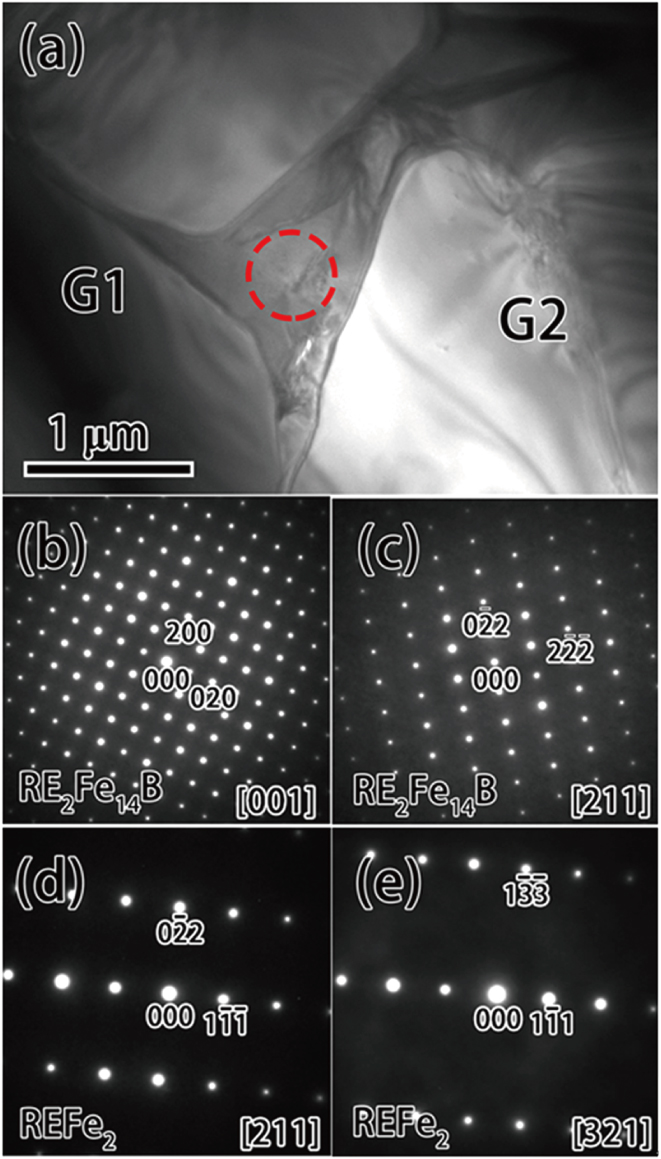 | Fig. 43. TEM characterizations for the Ce-45 MMP magnet. (a) Bright field image taken along the [001] zone axis of grain 1 (G1). (b) SAED pattern taken in the region of grain 1. (c) SAED pattern taken in the region of grain 2 (G2). (d) and (e) SAED patterns taken in the region indicated by the red dashed circle in (a) by tilting it to different zone axes, revealing a cubic structure (space group 
|
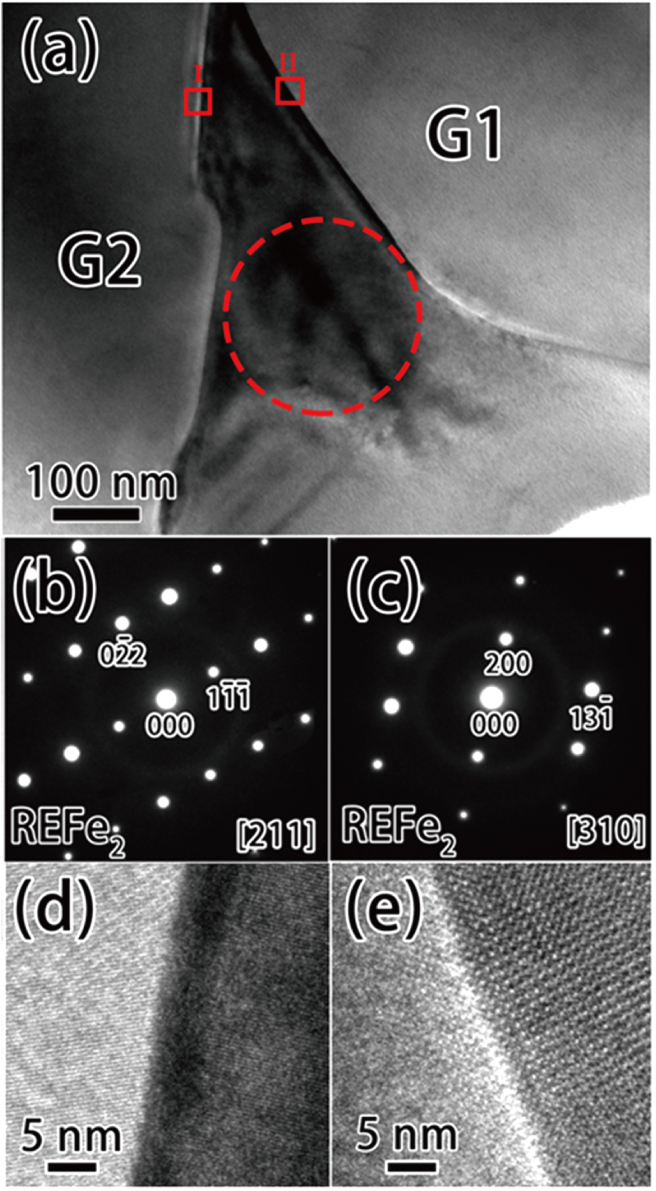 | Fig. 44. TEM characterizations for another typical region of the Ce-45 MMP magnet. (a) Bright field image taken along the [211] zone axis of REFe2 phase (triple junction). (b) and (c) SAED patterns for the triple junction region as indicated by the red dashed circle in (a) along two different zone axes. (d) and (e) TEM images with a high magnification taken from the regions indicated by the red squares I and II in (a).[6] |
The above characterizations confirm the existence of REFe2 phase in the intergranular regions of the MMP magnets, being consistent with the EPMA results in Fig.
Firstly, we investigated the initial phase constituents of the Ce-50 component powders by Rietveld XRD analysis, as shown in Fig. 


 | Fig. 45. XRD pattern for the Ce-50 component in powder form. The black dots show the observed experimental data and the red full line represents the calculated fits to the experimental data. Green line shows the difference between the fitted and observed results. The Bragg positions of RE2Fe14B, REFe2, and RE-rich phases are indicated by the short vertical bars in blue, red, and olive, respectively.[6] |
| Table 5.
Space group, crystal structure, lattice parameters, and mass fraction of the phases in the Ce-50 component evaluated by Rietveld analysis (Fig. |
After sintering and post annealing, the REFe2 phase is inherited from the Ce-50 component to the MMP magnets. In Figs. 
 | Fig. 46. XRD patterns for the powder samples of (a) Ce-45 MMP, (b) Ce-27 MMP, and (c) Ce-27 SMP sintered magnets. The black dots show the observed experimental data and the red full line represents the calculated fits to the experimental data. Green line shows the difference between the fitted and observed results. The Bragg positions of RE2Fe14B, REFe2, and RE-rich phases are indicated by vertical bars in blue, red, and olive, respectively.[6] |
Role of REFe2 phase on the microstructure of MMP magnets has also been investigated. Figure
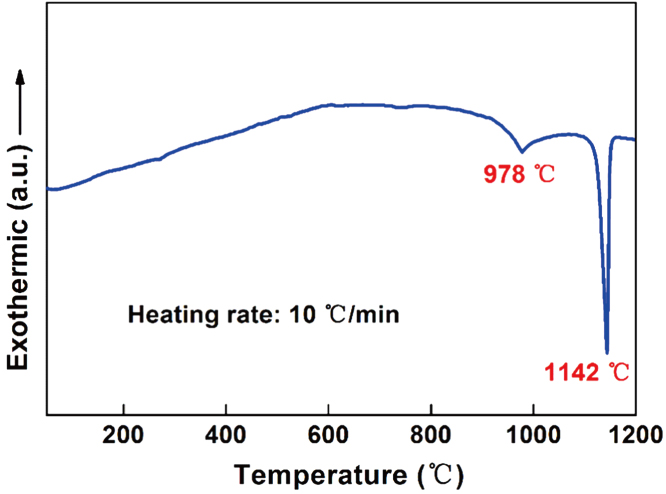 | Fig. 47. DSC curve for the Ce-50 component upon heating to 1200 °C at 10 °C/min.[6] |
Nd2Fe14B-type sintered magnets possess a liquid-phase-sintering process and the wettability between the matrix 2:14:1 phase and liquid phase plays an important role on the microstructure and magnetic properties.[103] The volume fraction of the liquid phase strongly affects the sintering process, which is essential for magnet densification. As schematically described for the SMP magnets (Fig.
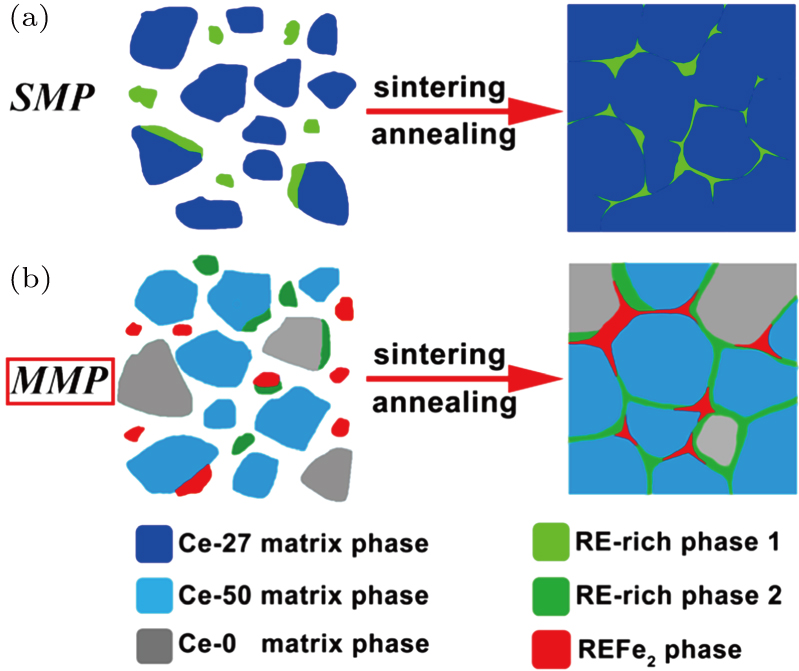 | Fig. 48. Schematic illustrations for the evolution of microstructure in (a) SMP and (b) MMP magnets during sintering.[6] |
Figure
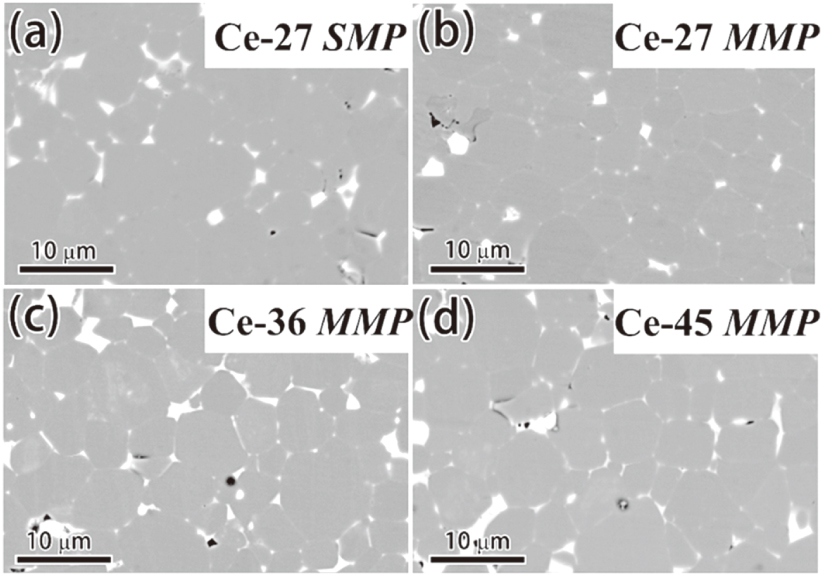 | Fig. 49. Back-scattered SEM images of the magnets: (a) Ce-27 SMP, (b) Ce-27 MMP, (c) Ce-36 MMP, and (d) Ce-45 MMP.[6] |
A thin GB layer is observed in the Ce-27 SMP magnet (Fig.
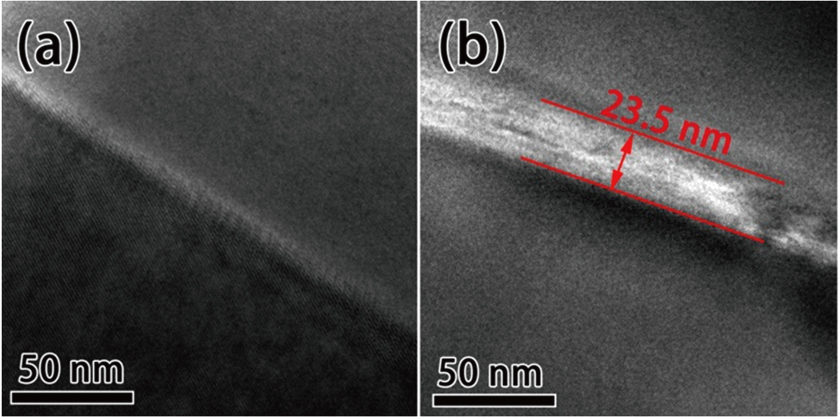 | Fig. 50. TEM images for the GBs between adjacent RE2Fe14B matrix phase grains: (a) Ce-27 SMP and (b) Ce-45 MMP magnets.[6] |
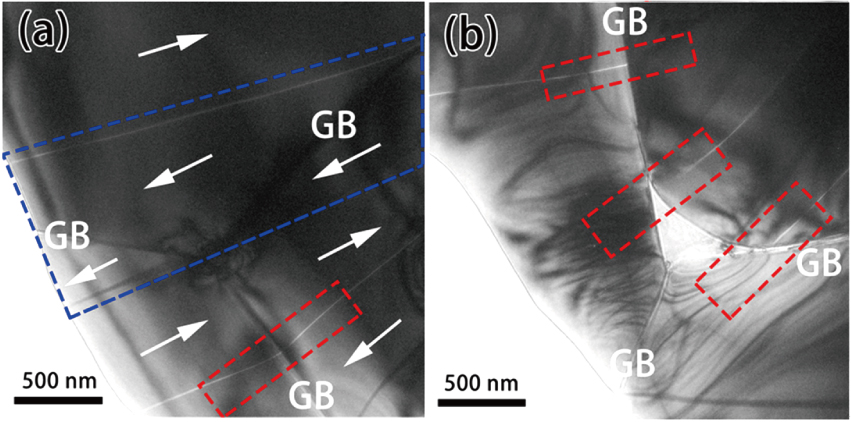 | Fig. 51. L-TEM Fresnel images of (a) Ce-27 SMP and (b) Ce-45 MMP magnets with the c-axis in plane and observed in the zero applied magnetic field. Red dashed rectangles in (a) and (b) highlight the domain walls. Blue rectangle in (a) indicates the magnetic domain across three different grains.[6] |
The existence of REFe2 phase helps to optimize the microstructure of MMP magnets. Previous literature[16] has also revealed the existence of minor REFe2 phase as independent grains in the high-Ce containing Nd–Ce–Fe–B magnets. Since CeFe2 is paramagnetic at room temperature (Curie temperature TC of 227 K[104]), its existence decreases the remanence of the Nd–Ce–Fe–B magnets. Although TC of the present REFe2 phase (containing Pr and Nd) could be different from that of CeFe2, it is usually deemed as a soft magnet below TC, being harmful to the hard magnetism. Its existence, however, is beneficial to optimize the microstructure and hence to enhance the coercivity. As revealed in Fig.
Effects of REFe2 phase on the microstructure and magnetic properties of (Nd, Ce)–Fe–B sintered magnets prepared by the MMP approach have been investigated.[6] (i) The REFe2 phase forms spontaneously in the initial Ce-50 component and inherits into the final MMP magnets. The REFe2 phase is mainly located in the intergranular regions, which distinctly differs from the conventional RE-rich phases in the Nd–Fe–B sintered magnets. (ii) The REFe2 phase melts during sintering due to its lower melting point than that of the matrix 2:14:1 phase, which enlarges the volume fraction of the liquid phase. It improves the wettability of the matrix phase grains and promotes the formation of continuous grain boundary phases. (iii) The continuous grain boundary layers are beneficial to isolate the adjacent matrix grains, i.e., to weaken the short-range exchange coupling between them, which is also an important reason for the retained coercivity of the MMP magnets. (iv) The positive role played by the REFe2 phase on microstructure suggests that the Ce substitution level in (Nd, Ce)–Fe–B sintered magnets can be further increased, enabling the fabrication of low-cost rare earth permanent magnets with magnetic properties fulfilling the gap between hard ferrites and commercial Nd–Fe–B magnets.
The current state-of-the-art techniques for enhancing the overall performances of Nd–Fe–B permanent magnets, including coercivity, corrosion resistance, HRE consumption, and high-abundant La/Ce/Y application have been presented in this review. The concluding remarks are summarized as follows.
1) Through replacing the traditional Nd-rich phase by the manually designed GB phase, the GBR approach provides effective solutions to the poor corrosion resistance, low coercivity, and high HRE utilization, the long-standing drawbacks of Nd–Fe–B magnets. Higher electrode potential of the new GB phase decreases the driving force for electrochemical corrosion between the matrix and intergranular phases, facilitating intrinsically the anti-corrosion stability. In the case of (Pr, Nd)32.5Fe62.0Cu5.5-restructured magnets, the mass loss against hot/humid atmosphere is remarkably lowered down to one sixteenth compared to the unrestructured one with the equivalent total RE content. Incorporating the low-melting-point Dy-containing alloys via the GBR approach, high coercivity without sacrificing the remanence and energy product can be acquired due to the (Dy, Nd)2Fe14B hardening shell as well as continuous GBs. More importantly, coercivity increment by per unit Dy addition can be effectively enhanced through the GBR approach, hence reducing the HRE consumption significantly. Altogether, the restructured 2:14:1-typed magnets exhibit high figures of merit, which are desirable for a wide range of technological applications. All the outstanding hallmarks root in the restructured GB phase, which substantially differs from the traditional Nd-rich phase.
2) It is generally acknowledged that high La substitution for Nd cannot be allowed due to severe 2:14:1 phase instability and drastic magnetism deterioration. However, we propose a new prototype of La–Ce co-substitution, where La of larger atomic radius induces the Ce valence shift towards the +3 state with an extra 4f electron, therefore strengthens the magnetization of the Ce-based tetragonal compound. High magnetic performance and mechanical properties can be obtained in the La–Ce co-substituted RE–Fe–B sintered magnets. For example, with 36 wt.% La–Ce concentration, high level of 
3) For (Nd, Ce)–Fe–B magnets, in addition to the RE2Fe14B matrix phase and RE-rich intergranular phase, the REFe2 phase also accounts for a substantial fraction in the GB regions, which highly affects the magnetic performance. This finding possesses far-reaching implications that if the GBR approach can be fully exploited and applied to the La/Ce/Y-rich RE–Fe–B magnets, the new difficulties concerning the GB regions are promising to be conquered. It sheds light on developing La/Ce/Y-containing RE–Fe–B magnets with deliberately tailored GB phases via the GBR approach, including the phase component, the elemental distribution, the volume fraction of GB phases, and so on. It will also in turn result in new understandings on the GB design to maximize the all-round performance of 2:14:1-typed permanent magnets.
| [1] | |
| [2] | |
| [3] | |
| [4] | |
| [5] | |
| [6] | |
| [7] | |
| [8] | |
| [9] | |
| [10] | |
| [11] | |
| [12] | |
| [13] | |
| [14] | |
| [15] | |
| [16] | |
| [17] | |
| [18] | |
| [19] | |
| [20] | |
| [21] | |
| [22] | |
| [23] | |
| [24] | |
| [25] | |
| [26] | |
| [27] | |
| [28] | |
| [29] | |
| [30] | |
| [31] | |
| [32] | |
| [33] | |
| [34] | |
| [35] | |
| [36] | |
| [37] | |
| [38] | |
| [39] | |
| [40] | |
| [41] | |
| [42] | |
| [43] | |
| [44] | |
| [45] | |
| [46] | |
| [47] | |
| [48] | |
| [49] | |
| [50] | |
| [51] | |
| [52] | |
| [53] | |
| [54] | |
| [55] | |
| [56] | |
| [57] | |
| [58] | |
| [59] | |
| [60] | |
| [61] | |
| [62] | |
| [63] | |
| [64] | |
| [65] | |
| [66] | |
| [67] | |
| [68] | |
| [69] | |
| [70] | |
| [71] | |
| [72] | |
| [73] | |
| [74] | |
| [75] | |
| [76] | |
| [77] | |
| [78] | |
| [79] | |
| [80] | |
| [81] | |
| [82] | |
| [83] | |
| [84] | |
| [85] | |
| [86] | |
| [87] | |
| [88] | |
| [89] | |
| [90] | |
| [91] | |
| [92] | |
| [93] | |
| [94] | |
| [95] | |
| [96] | |
| [97] | |
| [98] | |
| [99] | |
| [100] | |
| [101] | |
| [102] | |
| [103] | |
| [104] | |
| [105] |


